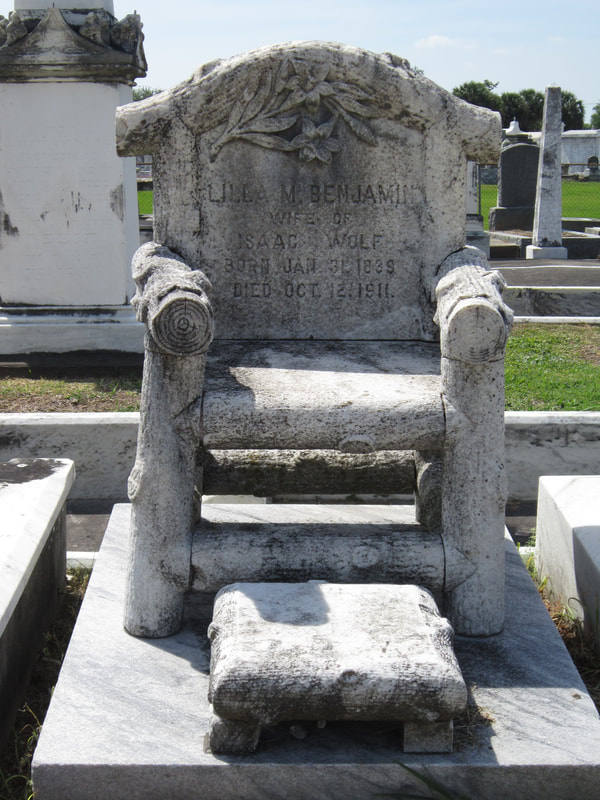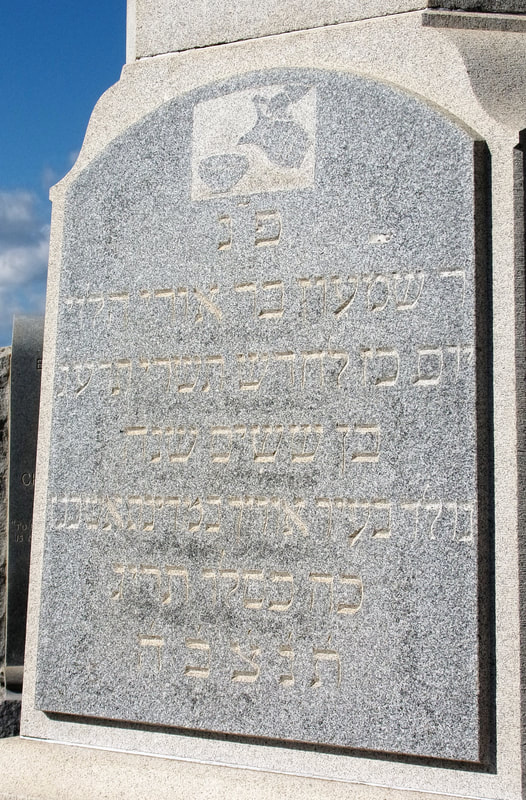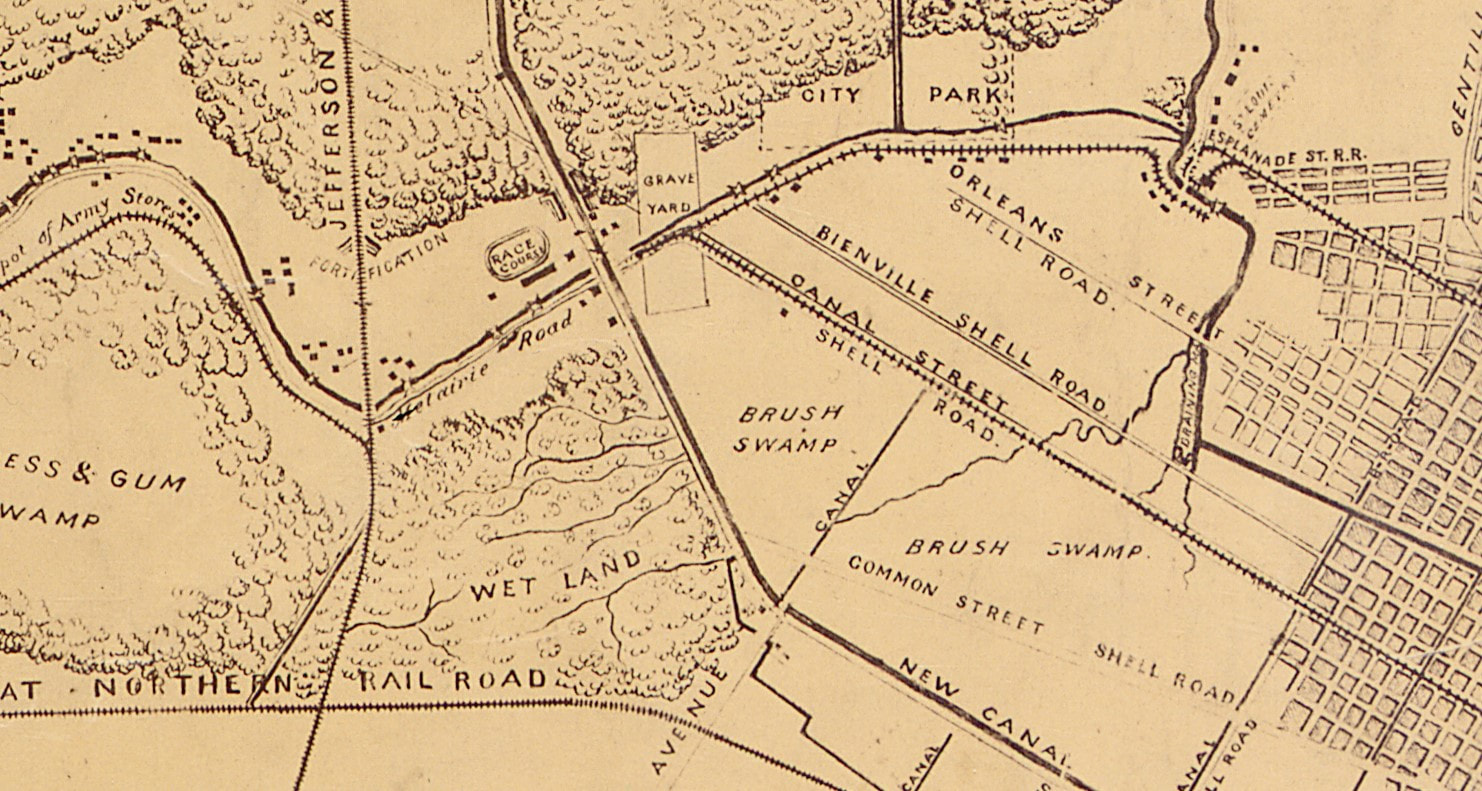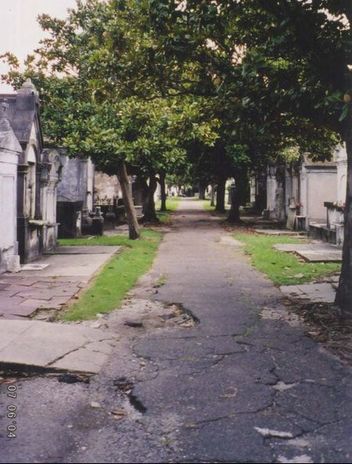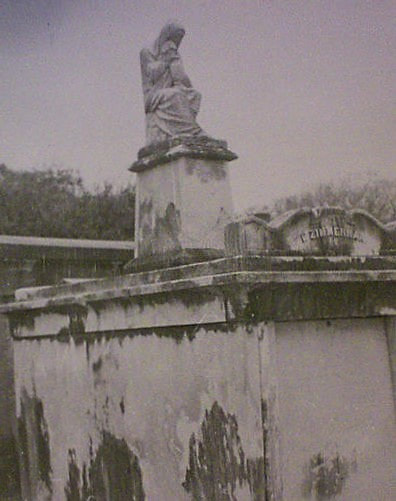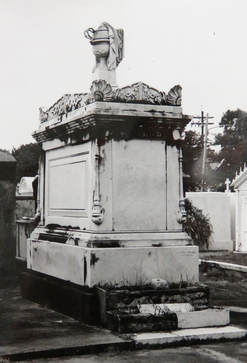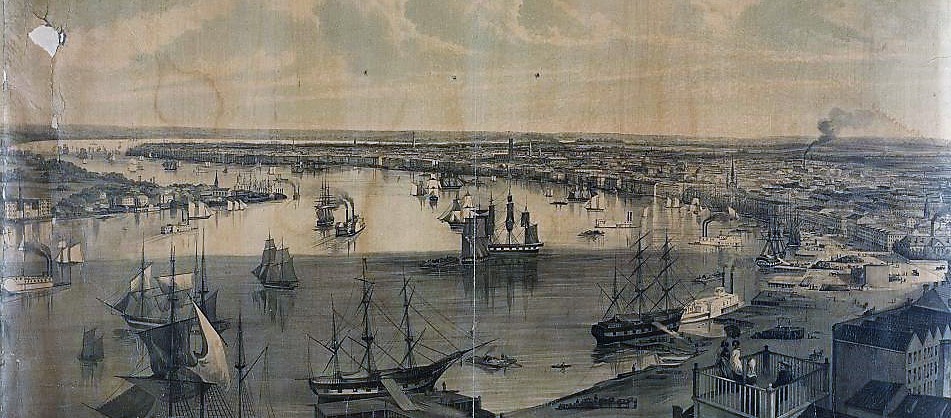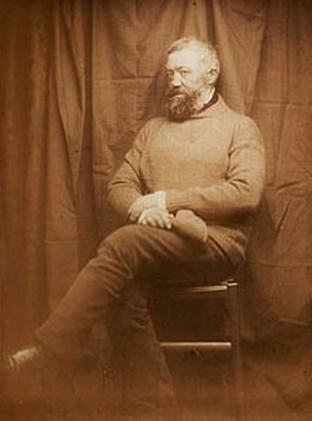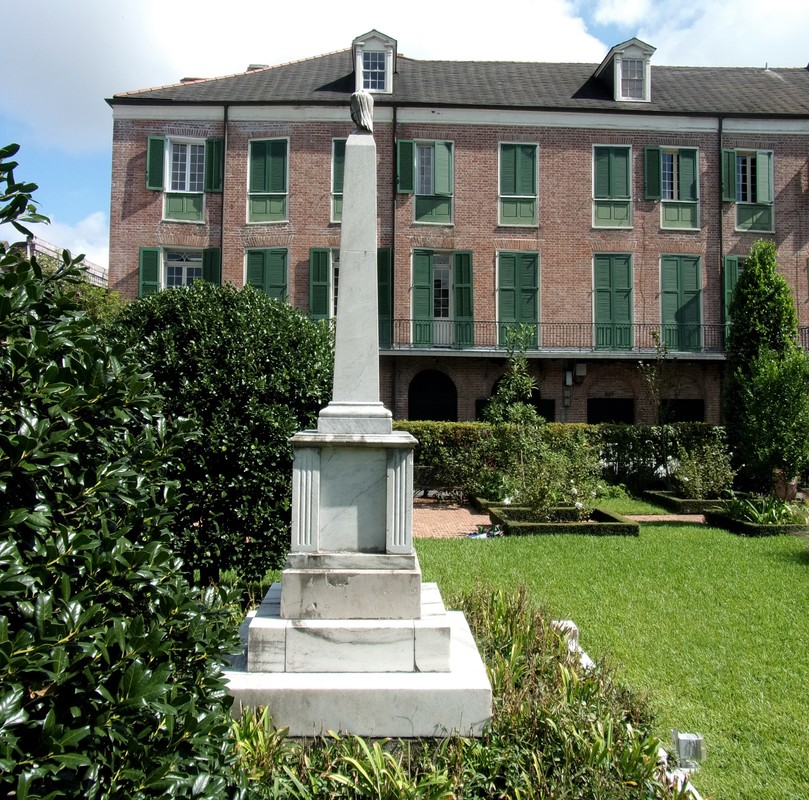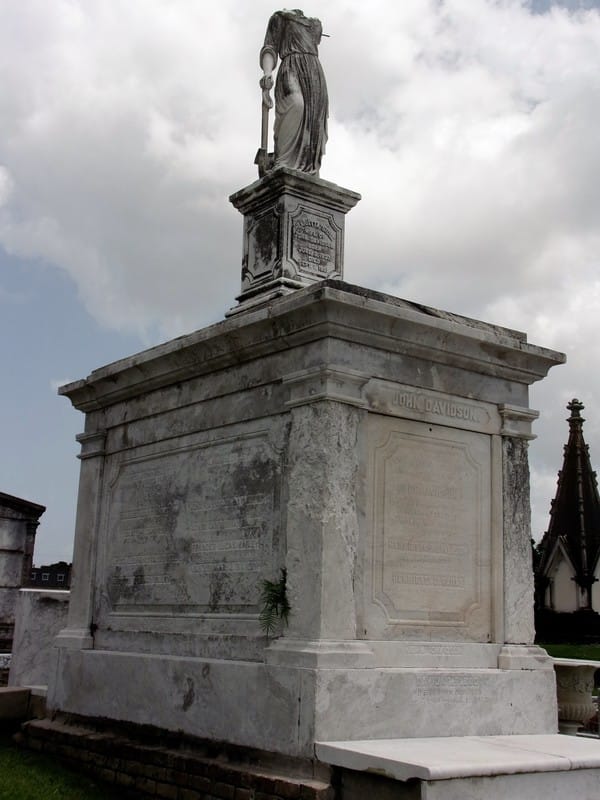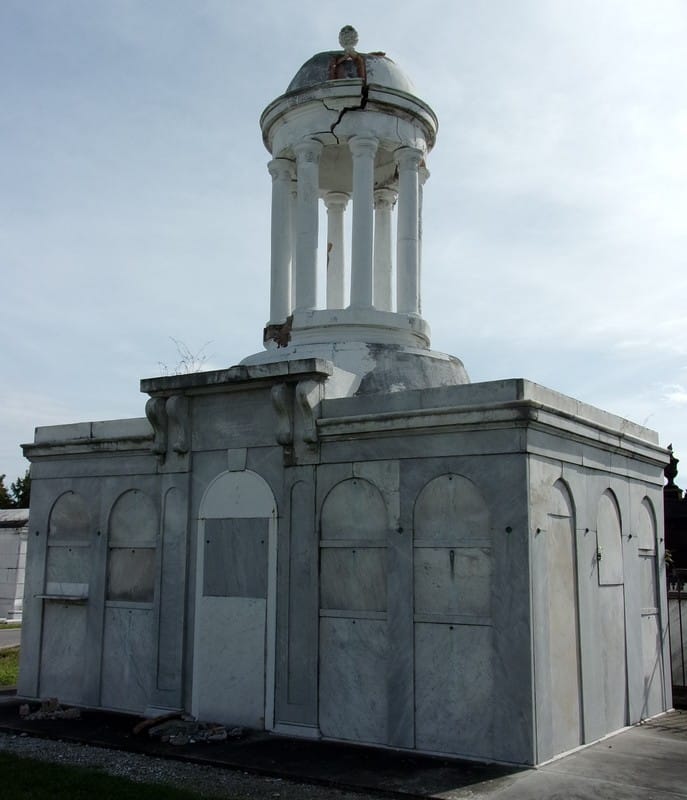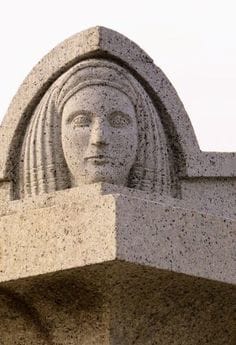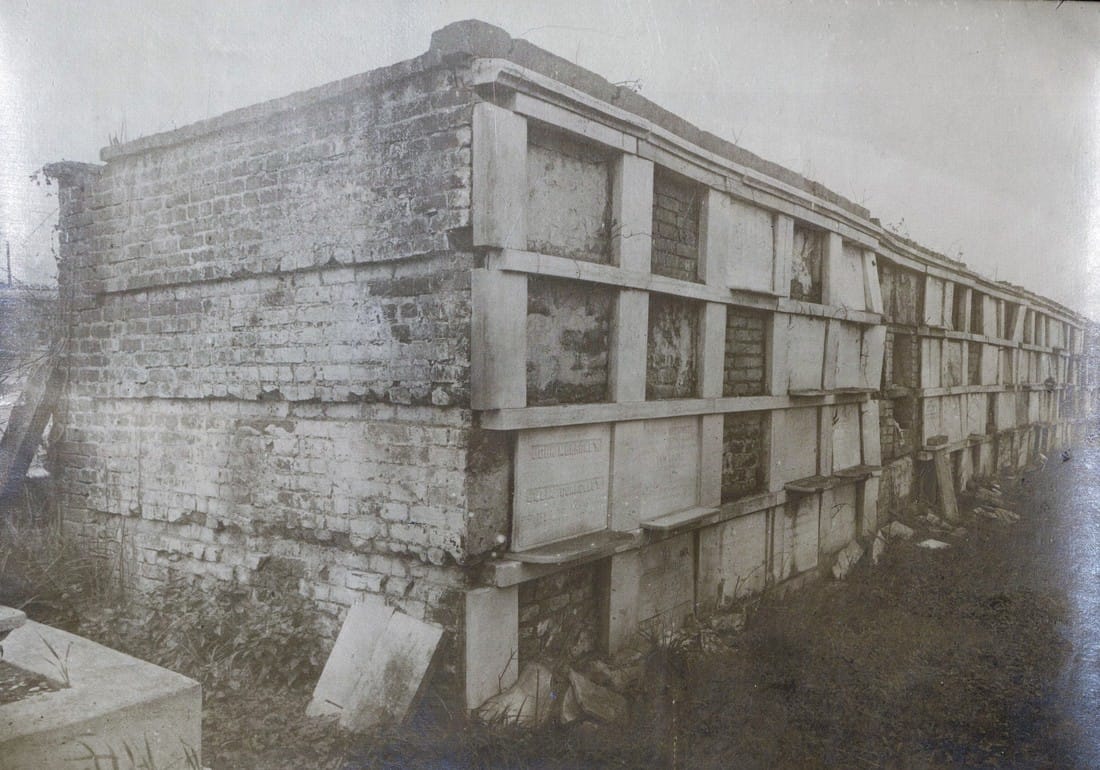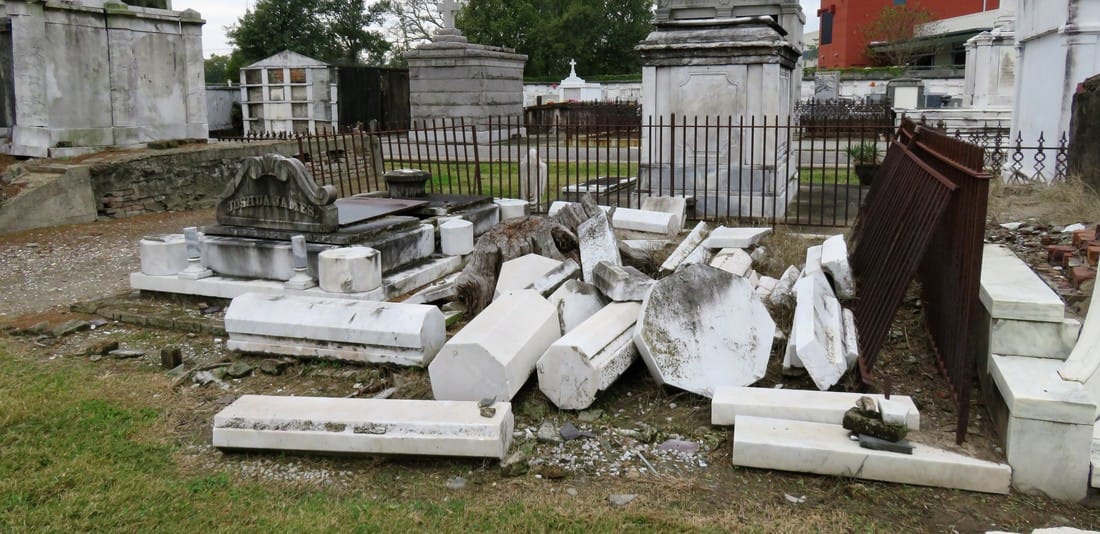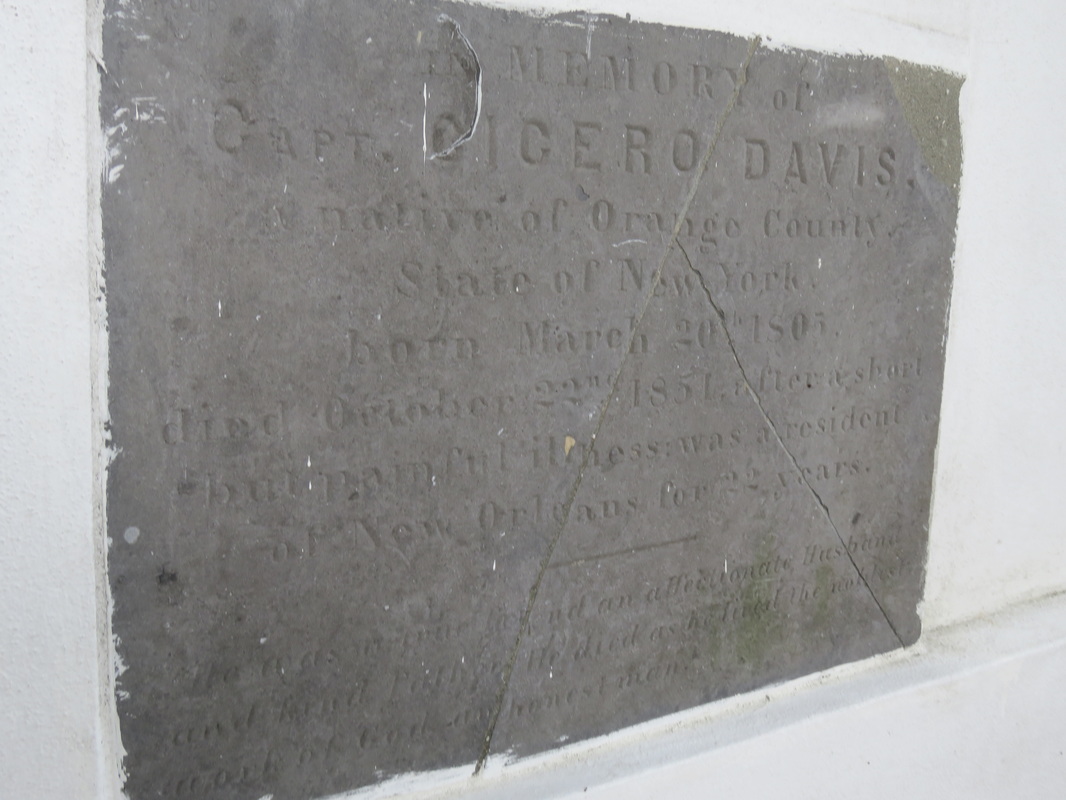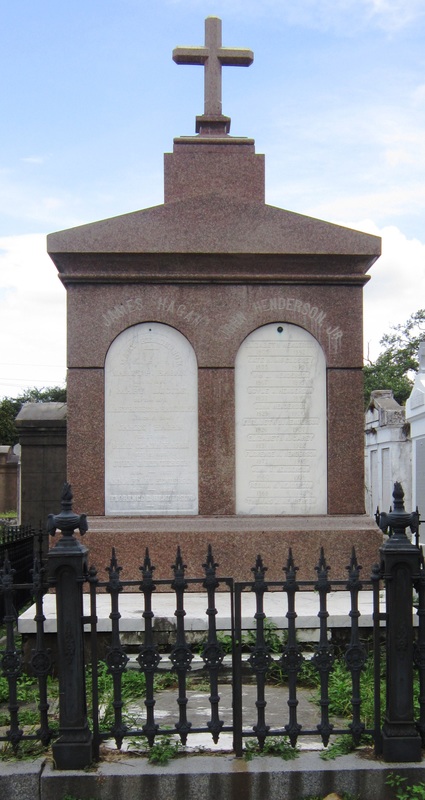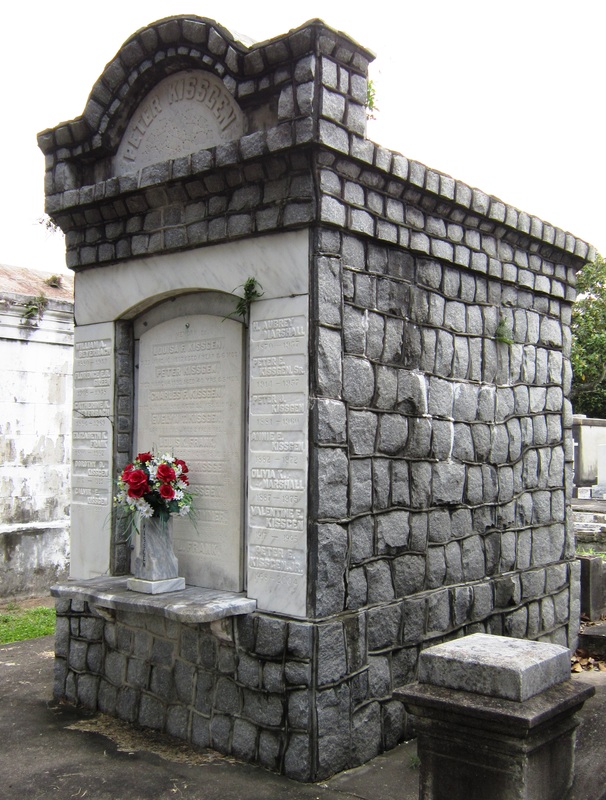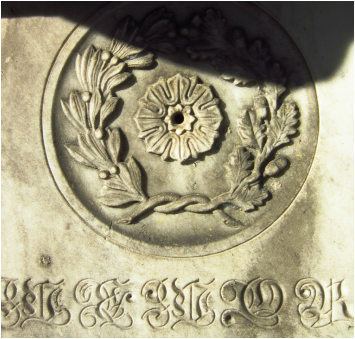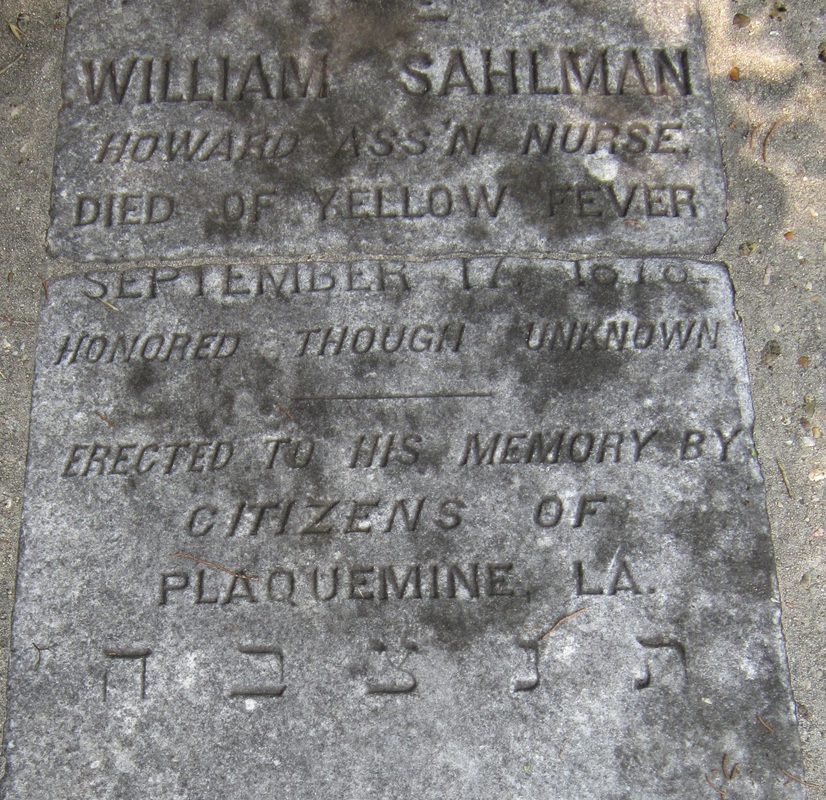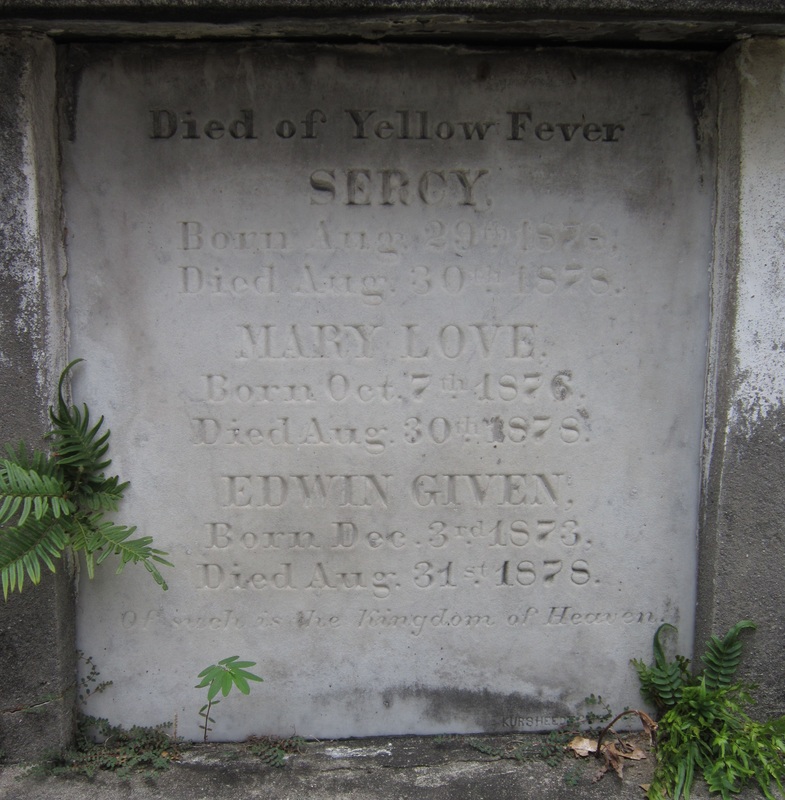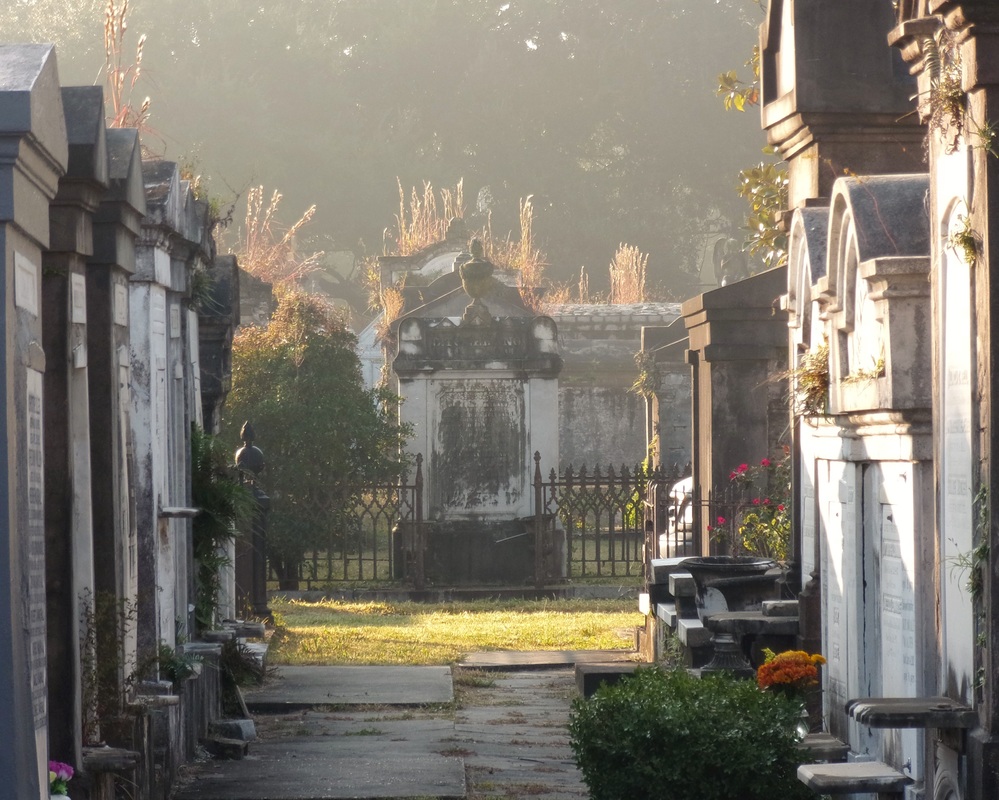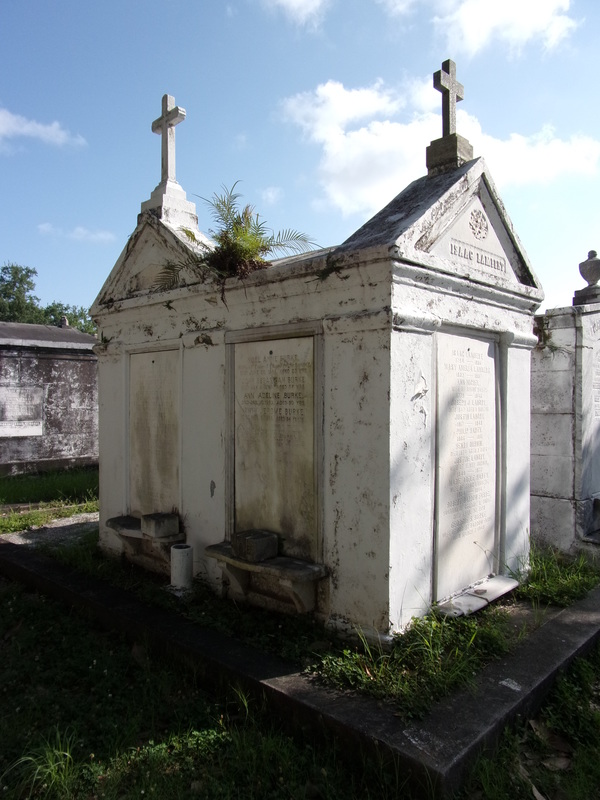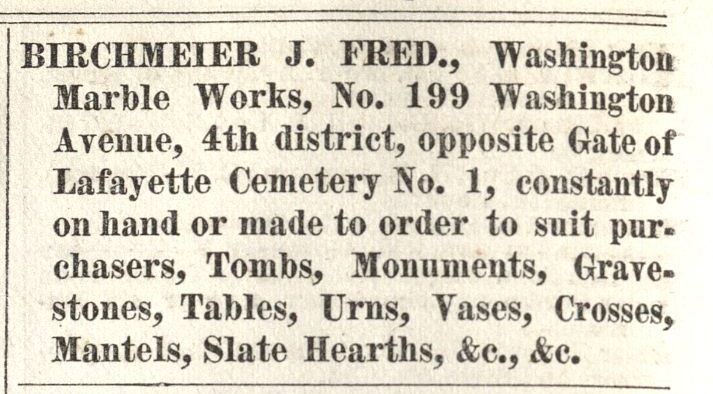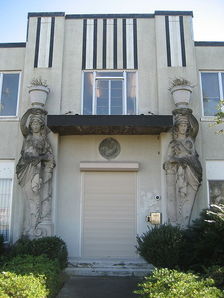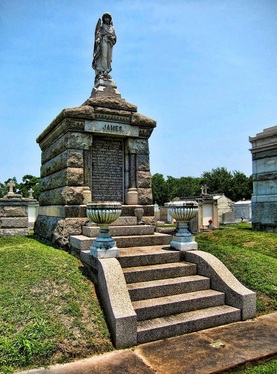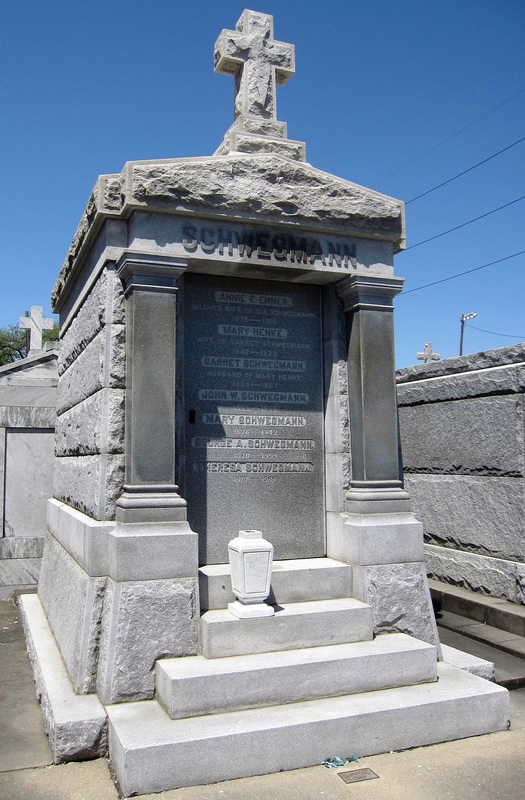|
How were some of New Orleans' most beautiful tombs designed, and why? The architecture of New Orleans cemeteries is as diverse and varied as the neighborhoods in which the cemeteries are set. On one end of town, St. Vincent de Paul Cemetery grew from a peaceful field in the 1830s into a florid, tightly-packed garden cemetery full of Spanish and Italian inscriptions by the 1860s. Far uptown, the Americans built Lafayette Cemetery No. 1 from a below-ground graveyard into a little city of stone tombs in the same period. Between the two of them, the French-Creole cemeteries St. Louis No. 1 housed several generations of architecture within its walls decades before either Lafayette No. 1 nor St. Vincent de Paul were even conceived of.[1]
Each tomb’s design in each cemetery is an adaptation of myriad influences, determined through the eye and imagination of mostly vernacular builders. Yet as is the case in all cemeteries, the appearance of the present is determined by what came before. In this blog post, we examine how a single influence gained a dual life in the form of the New Orleans sarcophagus tomb.
2 Comments
Irish-born Hagan was a state senator, a stonecutter, a real estate developer, and a dock commissioner in his long life, and Lafayette Cemetery No. 1 was deeply shaped by his work. Along the main aisle of Lafayette Cemetery No. 1, a pink granite tomb stands out from its lime-washed, marble-clad neighbors. Surrounded by a cast-iron fence, the tomb of James Hagan and John Henderson is often noted as the last resting place of a stonecutter whose work is prominent elsewhere in the cemetery. Yet this note, and the carved name of James Hagan, is only one small detail in the larger story of James Hagan’s life. James Hagan was not only a stonecutter but a real-estate dealer, state senator, community leader, and politician. He lived and worked in New Orleans not only in a time of great social change but a period of high craftwork and architecture in the city’s cemeteries. Among his signed works are some of the most ornate in Lafayette Cemetery No. 1, all marked by detailed stonework and expensive marble cladding.[1] Sources suggest that James Hagan built the pink granite tomb not for himself but for his first wife, Mary Henderson, after her death in 1872. Hagan married Mary Henderson in New Orleans shortly after he immigrated from County Armagh or County Antrim, Ireland, in approximately 1852.[2] James Hagan and his brothers John, Peter, and Patrick, as well as their mother, all fled Ireland in the 1850s after famine likely forced them to emigrate. In the Fourth District of New Orleans, formerly the New Orleans suburb of Lafayette, the Hagans joined thousands of other Irish who had formed a community along the banks of the Mississippi River in the neighborhood now known as Irish Channel.
This is Part Two in a multi-part blog series examining the landscape history of what is now the intersection of Canal Street and City Park Avenue. From July to November 2017, construction will take place at this intersection to connect the Canal Streetcar to Canal Boulevard. Find Part One here. 1841: St. Patrick’s Cemetery At the same time that Americans from the northeast were moving en masse to New Orleans, a separate wave of immigration from Ireland made a great impact on the city. Immigrants fleeing famine and political unrest in Ireland came to New Orleans and settled mostly in what is now the Faubourg St. Mary neighborhood of New Orleans, abutting the Central Business District and what is now the Crescent City Connection bridge. These immigrants formed what is now Irish Channel, although the boundaries of this neighborhood have changed over time.[1] The neighborhood formed from settlement patterns dependent on the construction of the New Basin Canal. In 1833, the Parish of St. Patrick was founded to accommodate Irish Catholics in the neighborhood. By 1840, St. Patrick’s Church was constructed on Camp Street.
The St. Patrick Cemeteries, so fresh and clean in their snow-white garb and pebbly walks, always attract attention. Here lie the sturdy Irish pioneers who came to New Orleans in the early part of the last century and helped to make her history the proud tale it is… they breathe throughout the spirit of the Catholic faith. Special attention is directed to the beautiful Calvary shrine at the further end of St. Patrick’s No. 1 and the Mater Dolorosa that marks the entrance to St. Patrick’s No. 2.[3] The Calvary statue was designed by then-prominent monument man Charles A. Orleans, consisting of “a wooden cross twenty feet high with life-sized statues of the crucified Christ, Mary Mother of Jesus, His beloved disciple John, and Mary Magdelene. The statues were cast in Paris.”[4] In 1973, in the midst of trends toward community mausoleums, the Calvary was removed to make way for the Calvary Mausoleum. 1846: Dispersed of Judah Cemetery Along with Americans and Irish immigrants to New Orleans, another group of established immigrants and newcomers found their burial place at the end of Canal Street. Jewish people had long lived in New Orleans in small communities, first of primarily Sephardic Jews (of the Spanish-Portuguese tradition) from the Caribbean and England, then later Ashkenazi Jews from Germany and Alsace-Lorraine. These communities first organized in 1828 to found Gates of Mercy congregation, which had a synagogue on Rampart Street near St. Louis Cemetery No. 1. Gates of Mercy was an Ashkenazi congregation, and Sephardic Jews in New Orleans sought their own place of worship. This hope was fulfilled in 1846 when organizer Gershom Kursheedt helped aging benefactor Judah Touro found congregation Nefuzoth Yehudah (Dispersed of Judah) in 1846. Dispersed of Judah, a Sephardic congregation, was one of many religious organizations to benefit from Judah Touro’s generous will, which also founded Touro Infirmary, later to become Touro Hospital. In 1881, Dispersed of Judah and Gates of Mercy congregations would merge. The new congregation was eventually renamed Touro Synagogue. In the same year Dispersed of Judah congregation was founded, property adjoining St. Patrick Cemetery No. 2 along Canal Street was purchased for a cemetery. Dispersed of Judah was the second Jewish cemetery in New Orleans. Gates of Mercy had established a cemetery on Jackson Avenue near Saratoga Street in 1828, but this cemetery was demolished in 1957, part of a trend that will be discussed in a later part of this series. Thus, Dispersed of Judah Cemetery is the oldest surviving Jewish Cemetery in New Orleans. Members of Dispersed of Judah congregation were often tied to English colonial or business interests, arriving in New Orleans from the English-colonized Caribbean or New York. This Anglo-cultural tie, as well as a religious need to bury belowground, allowed Dispersed of Judah to grow into a small version of a northern cemetery. The landscape today retains some elements of this – box tombs and obelisks, trees, and raised monuments. The cemetery is probably best known for the marble monument of Lilla Benjamin Wolf (died 1911), carved into the shape of an empty chair with foot stool. A local story tells the sale of Mrs. Wolf sitting in her chair in life, outside her family’s shop, calling potential customers inside. This may have been a deeply personal choice of monument for the Wolf family, although “the empty chair” was also a common funerary symbol at the turn of the century. 1848: Charity Hospital Cemetery By 1848, Charity Hospital was an institution nearly as old as New Orleans itself. Founded in 1732, the hospital provided care to all patients without regard to race, nationality, religion, or sex. Throughout the nineteenth century, Charity Hospital cared for thousands of newly-arrived immigrants who fell ill after the trans-Atlantic journey, or who were especially susceptible to New Orleans epidemics of yellow fever and cholera.[5]  Charity Hospital's fifth building, in use from 1832 to 1939. Located on Common Street between St. Mary and Girod Streets, it was replaced in the 1930s by "Big Charity," a building designed by Weiss, Dreyfus, and Seiferth, who also designed the Louisiana State Capitol at Baton Rouge. Image from Harper's Weekly, September 3, 1859, via archive.org.
The firemen used axes to demolish the fence to save the [adjoining] St. Patrick’s Cemetery property, but nothing could be done to prevent destruction, and, after the flames had consumed the grass, covered the graves under smoldering ashes, with no crosses or headboards to identify the original plots, nothing was left for the friends or relatives of the dead to distinguish one grave from the other.[7]  Charity Hospital Cemetery in 2003, looking over the fence from St. Patrick Cemetery No. 2 and toward Canal Street. The flags present on the site suggest that it may have recently been mapped using ground-penetrating radar (GPR) to identify gravesites. Photo by Dale Boudreaux, via usgenwebarchive.com Charity Hospital Cemetery would receive scores of burials each day during successive yellow fever and cholera epidemics. Later, the cemetery would also receive the bodies of those who had donated their remains in death as medical school cadavers. After Hurricane Katrina, the cemetery would be revised into a new kind of memorial. 1849: Odd Fellows Rest Charity Hospital was the third cemetery to be established at the end of Canal Street. By that time, the land was still overwhelmingly rural, with few structures save the Halfway House and Toll House along the Shell Road, and the towering Egyptian pillars of Cypress Grove. But around the same time Charity Hospital Cemetery was established, another great landmark was in the works. The Independent Order of Odd Fellows (IOOF), a fraternal organization established in England in the 1700s, had founded a local lodge in New Orleans in 1833. The origins of IOOF’s name seem debated; one explanation has been that the “Odd” designation came from the society’s openness to all members despite trade or occupation. The official IOOF website tells a different story: “…it was odd to find people organized for the purpose of giving aid to those in need.” Indeed, the IOOF’s stated purpose is “Visit the sick, relieve the distressed, bury the dead and educate the orphan.” The Odd Fellows were also known as the “Three Link Fraternity,” a reference to their motto “Friendship, Love, and Truth,” often symbolized by the three-link chain. By 1858, the Grand Lodge of Louisiana had more than twenty subordinate local lodges, including the Crescent, Teutonia, Howard, Magnolia, Covenant, and Polar Star Lodges, all beneath the IOOF Grand Lodge umbrella. In addition to establishing widows’ and orphans’ assistance, and constructing one, and then another imposing Odd Fellows Hall building, the local Odd Fellows sought to establish their own cemetery by the late 1840s. Odd Fellows cemeteries were a national phenomenon in the nineteenth century, and can still be found in places as disparate as New Jersey, Texas, Nebraska, California, and Oregon. New Orleans Odd Fellows sought to do the same. Previous to this time, the land acquired by respective cemetery owners like St. Patrick’s Church, Charity Hospital, and the Firemen had been allotted using lines of property demarcation corresponded to Lake Pontchartrain and not the Mississippi River, leading to the long lots exemplified best by St. Patrick Cemetery No. 1, 2, and 3. These property lines ran across Bayou Metairie at angles, leaving a small triangle of land wedged between St. Patrick Cemetery No. 2, Bayou Metairie, and Canal Street. In 1848, the Grand Lodge of Louisiana IOOF purchased this small triangle of land for use as their cemetery – the first, but not the last fraternal cemetery at the end of Canal Street.[8] On February 26, 1849, the various Odd Fellows Lodges converged on the Place d’Armes (Jackson Square) to form an “exceedingly beautiful” procession to celebrate the consecration of Odd Fellows Rest.[1] The parade of hundreds was decked in black crape, banners, and emblems of the many symbols recognized by the Odd Fellows. They marched through the French Quarter in a serpentine route, up one street and down another, across Canal Street and through the American Sector (now the Central Business District) where they converged at the New Basin Canal and boarded carriages to proceed up the New Shell Road to the Halfway House.[2] At the Halfway House, the Odd Fellows re-formed their procession, following a carriage drawn by six gray horses and carrying a sarcophagus containing the remains of sixteen Odd Fellows, exhumed from other cemeteries to be re-interred at Odd Fellows Rest. The procession entered through the cemetery’s gate, a granite Egyptian Revival post-and-lintel that mirrored in style if not size the grand entrance of Cypress Grove immediately across Canal Street. Once inside, the parade ended at the center of the cemetery, where a tomb had been prepared. Poems were read and oratories recited, and the remains reburied. The entrance to Odd Fellows Rest would remain at the center of its Canal Street boundary for more than fifty years. The granite entryway was enclosed by two cast-iron gates produced in Spain for the Odd Fellows that portrayed dozens of the Order’s symbols: cornucopia, beehives, globes, books, shepherd’s staffs, stars, axes, and a mother protecting four children. The gates were surmounted by finals depicting the sun and moon, and atop all of this was the perennial Odd Fellows Symbol, the heart-in-hand. In the mid-twentieth century, New Orleans photographer Clarence John Laughlin would capture the gates in their historic context, complete with detail and careful multichromatic paints. By the 1970s, much of the original ironwork had been stolen or lost. Within the walls of Odd Fellows Rest, the cemetery would be populated by hundreds of enclosed wall vaults, belowground burials, high-style tombs, and even a tumulus. In the 1850s, local sculptor and stonecutter Anthony Barret (1803 – 1873) constructed a 48-vault society tomb for the Teutonia Lodge of the Grand Order IOOF. The society tomb, later transferred to Southwestern Lodge No. 42, was designed reminiscent of an Italian loggia, with each arched group of vaults framed by inverted torches carved in marble. The Teutonia Lodge tomb was surmounted by marble urns on each corner of its roof. At the primary façade of the tomb was the piece-de-resistance of the structure: a remarkably ornate marble panel carved with dozens of symbols of the Order, each framed with fine scrollwork carved in relief. At the center of the panel, the protecting mother sits nursing a baby and wrapping her cloak around another child. Anthony Barret was well known for his remarkable stonework, carving some of the finest relief sculptures found in the Lafayette Cemeteries and elsewhere. Even still, the Teutonia Lodge tomb is the greatest artistic accomplishment of Barret’s to survive into the present day. [1] Campanella, Bienville’s Dilemma, 172.
[2] Dell Upton, “The Urban Cemetery and the Urban Community: The Origin of the New Orleans Cemetery,” in Exploring Everyday Landscapes: Perspectives in Vernacular Architecture, ed. Annmarie Adams and Sally McMurry (Knoxville: The University of Tennessee Press, 1997), 132-133, 139-140. [3] The New Orleans Picayune, The Picayune’s Guide to New Orleans (New Orleans: The Picayune, 1904), 152. [4] Leonard Victor Huber, Peggy McDowell, Mary Louise Christovich, New Orleans Architecture, Vol. III: The Cemeteries (Gretna: Pelican Publishing, 2004), 33. [5] John E. Salvaggio, New Orleans’ Charity Hospital: A Story of Physicians, Politics, and Poverty (Baton Rouge: LSU Press, 1992), 35-45. [6] “Second Municipality Council,” Daily Picayune, May 19, 1847, 2. [7] “A Cemetery Blaze: Flames Sweep the Spot where Charity Hospital Dead are Interred,” Times-Picayune, February 27, 1905, 11. [8] An 1833 map of New Orleans from the Mississippi River to Lake Pontchartrain shows the intersection of Bayou Metairie and the New Basin Canal divided into properties belonging to the New Orleans Banking and Canal Company, and illustrates how the property lines correspond with Lake-oriented parcels. A high-resolution of that map is available here. [9] “Consecration of Odd Fellows Rest,” Daily Crescent, February 27, 1849, 1. [10] Ibid. Published 144 years ago today in the New Orleans Times-Picayune, an interview with the assistant sexton of Lafayette Cemetery No. 1. It’s unclear how much of this article is speculative or fanciful, but in any case its content is fascinating. The article is presented here in pieces, with background inserted regarding the content. Original Times-Picayune narrative from July 13, 1873 is indicated in italics. Sitting on a Tombstone TALK WITH A GRAVEDIGGER --- “How long wil a man lie i’ the earth ere he rot?” [Hamlet] A reporter of the PICAYUNE, chancing in his peregrinations to stroll into the Washington Cemetery[1] in the cool of early morning, met and engaged in conversation with the assistant sexton. The term “sexton” is given to a person who maintains a cemetery in a professional capacity. It originated with a religious connotation, indicating a man who cared for both the church building and the adjoining cemetery. Later, as more and more cemeteries were established outside parish land, the term “sexton” migrated to the secular sphere. Lafayette Cemetery No. 1 was founded in 1833 as a municipal cemetery, and thus was never religiously affiliated. In 1873, the sexton of Lafayette Cemetery No. 1 and 2 was Joseph F. Callico (1828 – 1885). Callico was a free person of color who worked for most of his career beside St. Louis Cemetery No. 2, and also beside fellow stonecutter Paul Hippolyte Monsseaux. Around 1870, when Monsseaux himself ceased his business, Joseph Callico moved to Washington Avenue to serve as the sexton of the Washington Cemeteries. By 1875, he returned to St. Louis Cemetery No. 2, where his brother Fernand served as sexton.[2]
“Well, you know,” said the man, “there is a great difference in them. There are some here who, from their particular situation, keep much longer than others. There’s a man I came across the other day, digging a foundation for a tomb, who had been in the ground for two years, and he was in remarkably good condition. It is true, he was near the wall, and the drainage was good.” This passage offers some confirmation of what the landscape history of Lafayette Cemetery No. 1 suggests: that earlier below-ground burials were replaced by above-ground tombs. Dr. Bennett Dowler wrote in 1852 that Lafayette Cemetery No. 1 was a primarily a belowground cemetery, owing to the preference of Irish and German immigrants for inhumation over tomb burial.[4] Pre-1850’s burials in Lafayette No. 1 are difficult to find today, but most of which remain show some modification over time, suggesting that the assimilated children and grandchildren of immigrants later converted their family lots to traditional New Orleans tombs. This could be one reason the sexton came upon a burial while constructing a new tomb. The gravedigger expands on this notion in his next answer. “Do they bury many in the ground now in this cemetery?” “No,” said he “in this place most everyone has a tomb. You know, this yard has been buried some ten times over, and people don’t care to put their friends under earth when tombs don’t cost much more.” While “ten times over” may be exaggerated for Lafayette Cemetery No. 1 in 1873, the cemetery was declared “full” by Lafayette and New Orleans city councils in 1847 and 1856, respectively.[5] Neither of these ordinances was paid much mind, and burials continued. Furthermore, in the earliest years of the cemetery, between 1833 and 1853, approximately 30% of the individuals listed in interment books are noted as enslaved people. Amounting to thousands if not tens of thousands of burials, records do not indicate their location, although they are unlikely to be in the cemetery wall vaults.[6]  Excerpt of Lafayette Cemetery No. 1 interment books for August 1843. Over this week, burials included two deaths from dysentery, a twenty year old enslaved woman who died of consumption, and a death from "mania a potu," an historic term for alcohol-related illness, including delirium tremens. (New Orleans Public Library) From here both gravedigger and journalist get grim: “From your experience, what part of the body is the first to suffer from the effects of decomposition?” “The head goes first always. You see there isn’t so much flesh about it, and it doesn’t take long for it to go. The other parts go after it very soon; they all seem to go together.” While the good taste of asking this question in the first place is suspect, it is interesting to note the anachronism. In 1873, embalming had only recently become a possibility. The widespread practice of embalming starting in the twentieth century certainly affected the decomposition patterns of burials in New Orleans tombs and elsewhere. “In digging about these unoccupied places, do ever meet with the remains of human beings?” asked the reporter. “Oh, yes. The whole of Lafayette Cemetery has been filled, even to the avenues. When this was first a graveyard, it was not laid out regularly, and now when we have to repair the walkways, the bones are always turned up.” Prior to cement paving and other improvements that took place beginning in the 1940s, Lafayette Cemetery No. 1’s aisles were paved with crushed shells, marble pavers, and slate flagstones. Some of these paving materials remain visible. Archaeological test pits executed in the 1980s and 1990s indicated that crushed shells were regularly hauled into the cemetery to repave aisleways. This is likely the “repair to the walkways” the sexton mentions above. [more unnecessary description of decomposition] “Is there any difference between burying in the ovens and in the ground?” “Oh! Yes. In the ovens they don’t last six months, for with the metallic cases it does not take much time to destroy everything. In the ground, metallic cases, if they are good, last twenty years, and wooden ones about three."
"Yes! I have noticed that when they take on most they generally don’t come back to put flowers on the tomb much after the first month. “The widows come every week for about a month or two, fixing up everything. When they cry most they don’t come back at all, but when you see one who looks all the time at the coffin and doesn’t make a fuss you can be sure she will put flowers there for years.”
[1] Historically, Lafayette Cemetery No. 1 is frequently referred to as “the Washington Cemetery.”
[2] Louisiana State Board of Health, Biennial Report of the Louisiana State Board of Health, 1883-84, 40; Edwards Annual Directory…in the City of New Orleans for 1872 (New Orleans: Southern Publishing Company, 1872), 86; Edwards Annual Directory for New Orleans 1873 (New Orleans: Southern Publishing Company, 1873), 90; United States Census, 1880, New Orleans, Louisiana, Roll 461, Page 234C. [3] “All Saints’ Day – The Living Remember the Dead,” Times-Picayune, November 2, 1873, 1. [4] Bennet Dowler, M.D., “Tableaux, Geographical, Commercial, Geological and Sanitary of New Orleans,” printed in Cohen’s New Orleans and Lafayette Directory for 1852 (New Orleans: Office of the Daily Delta, 1852), 21. [5] Mayoralty of New Orleans, Common Council, City of New Orleans, “An Ordinance Relating to Cemeteries and Interments,” Daily Creole, December 30, 1856, 4. [6] New Orleans Public Library, Lafayette Cemetery No. 1 Interment Records, Vols. 1-5, microfilm. [7] Dowler, 21. New Orleans is home to dozens of cemeteries, each with its own character and history. Among these many burial and interment grounds are the influences of world cultures, human expressions of grief, and iterations of architecture that, in one way or another, are recognized as significant on small and large scales. Some are more appreciated than others. Some have been lost entirely from the landscape, such as St. Peter Street Cemetery, Girod Street Cemetery, or Gates of Prayer Cemetery on Jackson Avenue. Yet among these recognized and unrecognized burial grounds, there is one nearly always omitted, even though people walk by it and photograph it every day. Tucked behind St. Louis Cathedral and often overshadowed by the looming statue of the Sacred Heart of Jesus, is the final resting place of nineteen French navy men who died in 1857 and were re-interred at this place in 1914.
In the years following this harrowing incident, the surviving crew of the Tonnerre and their families in France, as well as French naval authorities, sought to memorialize the lost sailors. A monument was erected in the Quarantine Station cemetery in August 1859. The marble obelisk would not be seen for long, however. The Quarantine Station was soon relocated, with the former site abandoned. The monument would not be rediscovered until 1914, when Andre Lafargue endeavored to reclaim it.[3] The tale of the Tonnerre, its crew, and its monument, highlights so many historical aspects of the mid-nineteenth Caribbean and Atlantic world. It is a story of memorialization and reclamation, of the interactions between cultures and nations, and of the management of public health in this time. In this post, we seek to unpack some of these curious aspects of the monument that rises so subtly from behind St. Louis Cathedral. The Ship Tonnerre The Tonnerre is referred to in historical documents as both a corvette and an aviso or “advice ship.” While there appears to be some distinction between the two (and we don’t presume to call ourselves naval historians) – for example, avisos are customarily smaller than corvettes – documents consistently refer to the Tonnerre as a ship assigned the duty of relaying messages between larger naval commands. The four-gun Tonnerre was a steam-powered vessel, propelled by a paddle, and was inducted into service by the French Navy at Indret in 1838.[4] By 1850, the French Navy had about a dozen such first class “advice boats,” including five constructed of iron (Le Mouette, Le Heron, Le Eclaireur, Le Requin, and L’Epervier), although the Tonnerre was not constructed of iron. By 1857, the Tonnerre and its crew had already completed service in the Crimean War (1853-1856) in which an alliance of European powers fought Russia for influence over the Black Sea and Middle Eastern. Lieutenant Clement Maudet, who came to command the Tonnerre, fought with the French Foreign Legion in Crimea, earning a medal for his bravery. Many of the other sailors aboard the Tonnerre served in this conflict before being dispatched to the Caribbean. The presence of the Tonnerre in the Caribbean also highlights the colonial and military interactions in the Caribbean and Atlantic world at the time. The Tonnerre was charged with relaying messages between Vera Cruz and Havana (a role the ship would serve through the late 1850s).[5] The ship’s mission likely related to French economic and political interests in Mexico, which Emperor Napoleon III viewed as critical to Latin American trade access. French intervention would escalate to full on invasion in 1861, and later the unsuccessful installation of Hapsburg emperor Maximilian I. It was in this conflict in 1863, that Lieutenant Clement Maudet would die of wounds acquired in the Battle of Camerone.[6] The Tonnerre was the fifth ship of the French navy to bear this name. The first French Naval Tonnerre was the British HMS Thunder, captured in 1696. The Tonnerre under Maudet’s command in 1857 was retired in 1878. The French Navy currently operates the eighth Tonnerre, placed into active service in 2006. The Crew The Tonnerre had an original crew of eighty sailors, including a doctor (who died of yellow fever at the Quarantine Station), sailors, ensigns, stokers (steam engine operators), chefs, and mates. Eighty of whom contracted yellow fever either in Mexico, Louisiana, or Cuba. Thirty of these seamen died. Two of the chefs aboard the Tonnerre who perished in 1857 appear to have been of Italian descent: Giovanni Carletto and Jean Janotti. Ages of the men who died aboard the Tonnerre are not listed.
In 1853, for example, the fever was presumed to be caused by “miasmas” or “bad air” (a theory derived from Enlightenment thought), and thus the City burned torches of pitch and discharged cannons in order to disperse airborne maladies. By the 1850s, the Sanitarian movement had begun to marginally influence public health, focusing on cleanliness of public spaces and the removal of fetid water. Quarantine Stations were present in most eastern seaboard cities by the early 1800s. In New Orleans, the necessity of such stations was frequently debated and they were often decommissioned. In many cases, New Orleans merchants were staunch opponents of quarantine. Such systems, they said, disrupted commerce and were thus unacceptable. Their arguments appeared validated when, on occasion, epidemics broke out despite the presence of quarantine stations – likely due to the yellow fever mosquito (Aedes aegypti)’s fondness for sheltering in ship cargo holds. Incidentally, however, 1857 was not a significant epidemic year for New Orleans. As the Tonnerre had no intention of docking in the City en route to Havana, the condition of this one ship’s crew posed little danger of epidemic to the Crescent City.
The Quarantine Station would be abandoned after the 1860s, after the US Government established an additional Quarantine Station at Ship Island, Mississippi. In 1880, the Louisiana Board of Health reported on the condition of the Ostrica-area Station, the grounds “open and roamed over by cattle.[10]” It described a complex of several buildings: a fever hospital, a pox hospital, a medical residence, a boatmen’s quarters, and a warehouse. Said the board of the process of disinfection at the hospitals: The process of disinfection now employed consists of burning sulphur in iron pots. These pots are placed in tubs containing water. This method is liable to the grave objection that there is, in many cases, and especially during rough weather, danger of firing the ship.[11] In this report, the Board of Health appears to be investigating the feasibility of placing the Station back into service, although no evidence suggests this happened. However, the report documented the enduring presence of the Tonnerre monument: The graveyard of the Quarantine Station is located about 200 feet to the rear of the Fever Hospital, and is surrounded by a rude fence and covers about three-fourths of an acre. Marks of about one-hundred graves can be discerned by the inclosure [sic], which are thickly covered with tall grass, brambles, and shrubs. There is only a solitary marble monument, which bears the following inscription: "A la mémoire de Trente Marins, faisant partie de l'équipage de l'avito vaisseau de la Marine Imperiale le Tonnerre, décède à la Quarantaine de la Nouvelle Orléans en Août, 1857. Erige par l'Odre de S.E. L'amiral Hamelin, ministre de la Marine de l'Empereur Napoléon III.”[12] The Monument Thanks to donations from the families of surviving Tonnerre crewmen, a marble monument was installed at the Quarantine Station in 1859. Unfortunately, the craftsperson that designed and built it is unknown. Photos from the monument’s recovery indicate that it was originally a marble-clad box tomb, with fluted corner pieces and a marble slab atop which the monument’s obelisk and urn were fixed. This style of memorial was typical of 1850s high-style cemetery architecture in both New Orleans and France. Derived from sarcophagus designs, similar monuments can be found in the cemeteries of Montparnasse (France) and St. Louis Cemetery No. 2, although less modified versions are visible in the upriver parishes. The Tonnerre monument was described intact by the Louisiana Board of Health in 1880, even though the Quarantine Station cemetery had become derelict. Andre Lafargue shares a similar recollection from his youth, seeing the monument ascending from the brush as he traveled the river. Lafargue notes that at some time between 1880 and 1914 the obelisk fell in a hurricane.[13] The Quarantine Station long abandoned, without intervention the Tonnerre monument would have sunken beneath overgrowth and debris. Yet in 1914, Andre Lafargue, who at that time served as the attorney for the Comité du Souvenir Francais, came across in the French Society records documentation of the Tonnerre monument. In an effort that proved fruitful if not also tremendous and risky, Lafargue chartered a boat from Buras to Ostrica, bringing with him the vice French consul general at the time, Andre Lacaze, and their wives.[14] Trudging through the brush with only a vague recollection of where the cemetery and Quarantine Station once stood, the party discovered the remains of the monument: We finally came to a spot, near a tree of greater dimensions than the others, and there found traces of former habitations, and all of a sudden our feet struck a pile of bricks and pieces of marble and we knew, after examination of the fragments, that we had finally found the spot where the cemetery stood long years before and where the monument had been built. The ladies, highly elated by the discovery, were very helpful in picking up various pieces of the pedestal and we finally located the obelisk, the main section of the most important part of the monument, and the gracefully draped urn. The urn had been wrenched from the top of the obelisk and the latter had broken into two pieces in its fall to the ground, after the pedestal and the foundation had been undermined by the elements and the rough usage of time.[15] Over the course of subsequent trips to the site and through partnerships with groups like the Societe de Bienfaisance et d’Assistance Mutuelle, the monument was packed away and sent upriver to New Orleans. Despite the contestations of local undertakers that recovery of the remains of the 19 seamen who died at the Quarantine Station would be impossible, Lafargue and his crew set out to disinter each one. Each body was laid beneath the flag of France during disinterment, then shrouded and placed together in a metallic casket, where a single French flag was draped across them. In an additional gesture of reverence, the party uprooted a small tree from the cemetery and placed it in the coffin with the remains, to be re-planted at the new monument site.[16] The monument was reconstructed by New Orleans stonecutter and tomb builder Albert Weiblen. Weiblen built a burial vault atop which the monument would sit and bordered with a Georgia Creole marble coping wall. This vault forms a tumulus structure and simultaneously elevates the monument. Weiblen’s skill in reconstructing the monument is remarkably evident: it is difficult to determine which elements of the monument are replacements and which are original. But some clues are visible: one inscribed tablet is of a slightly different type of marble, and is inscribed with a pneumatic tool, whereas the other inscribed faces of the pedestal have smaller, hand-carved lettering. It appears as if the monument itself may have been slightly downsized, it’s dimensions shaved away to remove damaged or unsalvageable elements. A small bronze plaque was installed at the front of the coping by De Lucas Monument Company at the cost of $13.[17] Since its rededication, the Tonnerre monument has survived a few more hurricanes, and an instance in the 1930s in which an inebriated driver crashed through the gates of the Cathedral garden and toppled the obelisk. But for the most part the monument (and the remains therein) have known peaceful repose, quietly situated between St. Louis Cathedral and Royal Street, so often escaping notice. [1] Andre Lafargue, “The Little Obelisk in the Cathedral Square in New Orleans,” Louisiana Historical Quarterly, Vol. 28, No. 1 (Jan. 1945), 329.
[2] Every history of the Tonnerre’s trials at the Louisiana quarantine station omits the commander’s first name. Based on other histories of the French Navy in the Baltic and Mexico, and other statistical data, the commander of the Tonnerre was most likely Clement Maudet (1829-1863), French Legionnaire, who would die later in Mexico during the Battle of Camarone, part of the Second French Intervention. [3] Ibid., 333-336. [4] John Fincham, A History of Naval Architecture, to which is prefixed an introductory dissertation on the application of mathematical science to the art of naval construction (London: Whittaker and Co., 1851), 408. [5] French war steamer Tonnerre embarks from Havana to Mexico, Daily Picayune, October 21, 1857; French war steamer Tonnerre returns to Havana, Daily Picayune, December 14, 1857. [6] This is an extremely generalized recapitulation of colonialism in the Caribbean in the 1850s. For further reading see: The Second French Intervention in Mexico, The French Intervention in Mexico and the American Civil War, and if all of this is too complicated or frustrating, just check out this fun comic. [7] Henry Rightor, Standard History of New Orleans, Louisiana (New Orleans: Lewis Publishing Company, 1900), 211-213. [8] John Duffy, The Sanitarians: A History of American Public Health (Chicago: University of Illinois Press, 1992), 60; Joy J. Jackson, Where the River Runs Deep: The Story of a Mississippi River Pilot (Baton Rouge: LSU Press, 1993), 55; Alcee Fortier, Louisiana: Comprising Sketches of Parishes, Towns, Events, Institutions, and Persons, Arranged in Cyclopedic Form, Vol. 2 (Century Historical Association, 1914), 337. Jackson notes quarantine stations located at Cubit’s Gap (around 1910) and a post-1920 station at the lower end of Algiers. Andre Lafargue describes a quarantine station at Pilot Town, twenty miles downriver from Ostrica, by 1914. [9] John Duffy, ed. The Rudolph Matas History of Medicine in Louisiana, Vol. II (Binghamton, New York: Vail-Ballou Press, Inc., 1962), 185-186. [10] Joseph Jones, M.D. Report of the President of the Board of Health of the State of Louisiana for the Year 1880, 14. The report also notes the success of quarantine measures for that year, including the removal of the bark Excelsior, bound from Rio de Janiero, to Quarantine, which “certainly freed the city of New Orleans from the infected crew, and in the opinion of a portion of at least of the medical profession, preserved the citizens from an epidemic.” [11] Ibid., 18. [12] Ibid., 15. [13] Andre Lafargue, “The Little Obelisk in the Cathedral Square in New Orleans,” 336. [14] John Smith Kendall, A.M., History of New Orleans, Vol. III (Chicago: Lewis Publishing Company, 1922), 1149. [15] Ibid., 338. [16] Ibid., 336-342. There is no indication that this tree remains in the garden behind St. Louis Cathedral. [17] Receipt from De Lucas Monument company to Comite Francaise, Andre Lafargue papers, MSS 552, Folder 10, Tulane Louisiana Research Collection. Part Two of Two in an examination of historic architectural landscapes at Cypress Grove Cemetery. Find Part One here. In the 1840s, Cypress Grove Cemetery developed into the landscape its founders envisioned: tree-lined and populated with tombs of the finest order. It also gained company as St. Patrick’s Cemetery, Charity Hospital Cemetery, and Odd Fellows Rest were all established between 1840 and 1850. There at the corner at what is now Canal Street and City Park Avenue, Cypress Grove was part of a pastoral scene: barges floating up Bayou Metairie and the New Basin Canal, visitors strolling the gardens at the Halfway House, and rail cars pulling up right to the cemetery gates, unloading mourners and the bodies of the mourned.[1] Between its founding in 1840 and the turn of the century, Cypress Grove would become the final resting place of many famous and infamous New Orleans characters. Northern-born transplants to the city would combine New Orleans tomb architecture with the styles and materials they were accustomed to. Firemen would memorialize their fallen brethren within the cemetery’s marble-clad walls. Much of the incremental detail of the cemetery at its height, though, has weathered away from its present-day appearance. It’s easy to miss this historic garden cemetery for its modern lack of trees. But with historic research and a keen eye, it’s possible to rediscover Cypress Grove’s historic grandeur. Firemen, Northerners, and Protestants Cypress Grove was the first fraternal cemetery in New Orleans. All other cemeteries founded up to 1840 belonged either to the Catholic parishes (except Protestant Girod Cemetery, belonging to Christ Church Cathedral) or to each respective municipality (i.e. Lafayette Cemetery No. 1). Many other fraternal organizations, including other firemen’s organizations, would found their own cemeteries over the course of the nineteenth century. Cypress Grove was not intended for the exclusive burial of firemen. It served all New Orleanians seeking burial, if they could purchase a plot, and many who could not. Cypress Grove Cemetery No. 2 (present-day Canal Boulevard) was contracted by the City of New Orleans for indigent burial, even after Charity Hospital Cemetery was established in 1848.[2] While Catholics in New Orleans had many cemeteries from which to choose, Protestants had only Girod Street Cemetery and the municipal cemeteries. Perhaps it was simple economics that caused so many Northern-born Protestants to buy property in Cypress Grove. It may also have been caused by cultural interaction between the Firemen (many of whom were also non-native New Orleanians) and others who joined them as newcomers in the Crescent City. In any case, the great majority of historic burials in Cypress Grove denote birth in northern climes such as Pennsylvania, New York, Connecticut, and others. The Firemen’s Charitable Association fell into this market easily. Stonecutters whose work featured mostly in Girod Street Cemetery, such as long-time Girod Street sexton Horace Gateley, executed tombs and tablets in Cypress Grove as well. Gately himself, who drowned in at Isla del Padre, Texas in 1867, is buried in adjoining Greenwood Cemetery. The FCA even advertised in-ground burial in Cypress Grove. While in-ground burial occurred in nearly every cemetery in the city, FCA was the only cemetery owning body to advertise it – plainly appealing to newcomers with a distaste for Continental-inspired above-ground tombs.[3] When Girod Street Cemetery was demolished in 1957, Cypress Grove became a de facto artifact of what the Protestant cemetery may have looked like. Simpler, sarcophagus-style tombs with accents placed more on great obelisks and sculpture than on Greek acroteria or Baroque scrollwork dotted the aisles of both Girod and Cypress Grove. What few photos of Girod Street Cemetery remain even suggest a few duplicate tombs between both cemeteries: including the now headless and armless tomb statue and tomb of Henrietta Sidle Davidson (died 1881) and another tomb in Girod Street. Philadelphia brick, New Hampshire granite, and other Anglo-inspired tastes contributed to the budding landscape of Cypress Grove.
Mr. [S.T.] Jones placed a closely sealed bottle in the box, containing the constitution and list of members of this efflisient [sic] company, the daily newspapers of the city, and the various coins of the country. This was also embedded in mortar, the cover put on, and the whole covered with solid masonry, upon which the corner stone was laid. The beauty of the day, the solemnity of the occasion, and the mournful memories engendered by the scenes around, all contributed to give the ceremony a peculiar interest.[5] The tomb of Perseverance Lodge No. 13 dominated the entrance of Cypress Grove Cemetery then as it does now – a large terra cotta cupola with ionic columns and a cast-iron finial at its dome was constructed atop the tomb roof. At the center of its primary façade, an entrance was likely constructed which was enclosed by cast-iron doors. Above this door were marble brackets and a Classical pediment. The tombs of Philadelphia Fire Engine and Eagle Fire Company were tucked into the front corners of the cemetery. Each built identically, with marble-clad masonry and large urns and finials, they were each enclosed with iron gates, each within the line-of-sight of the Irad Ferry monument. Masterpieces in Marble and Granite Other societies in addition to fire companies would build their tombs in Cypress Grove, most notably the Chinese tomb and Baker’s Benevolent Association tomb. But Cypress Grove would make its mark in the number of great family tombs that populated its aisles. The sarcophagus tomb is one of the most notable artifacts of funerary architecture in New Orleans cemeteries, and in Cypress Grove this was no different. Built of brick and clad in marble pilasters, cornicework, and sculptural elements, the sarcophagus tombs of the McIlhenny, Davidson, Johnston and Walker tombs are examples of the dozens of this burial type found in Cypress Grove. Built by stonecutters like Anthony Barret, James Reynolds, and Newton Richards, they represented the English-speaking stonecutter’s take on a burial style often associated with Creole artisans. The French-speakers were present in Cypress Grove, as well. Sarcophagus tombs by signed by Florville Foy are present beside the work of New Orleans-born Jewish stonecutter Edwin I. Kursheedt. Renowned French-born cemetery architect J.N.B. de Pouilly designed two of the best-known tombs in Cypress Grove: those of Maunsel White and Irad Ferry (constructed by Monsseaux and Richards, respectively).
The only remaining example of this style of historic tomb construction lies not in Cypress Grove but in Metairie Cemetery – the Duverje family tomb, constructed between 1808 and 1820 and moved from the family cemetery in Algiers in 1916, retains such acroteria. They are the last of their kind in New Orleans cemeteries. Then and Now After 1945, New Orleans cemeteries underwent a seismic shift in management, industry, and trade. The monument industry had been slowly becoming a national affair managed by large companies – a shift that reached New Orleans after World War II. Over the years, most cemeteries abandoned the employ of the cemetery sexton who traditionally cared for the grounds on a daily basis. Stonecutters, who had often served as sextons, adapted and became cemetery owners and dealers of nationalized products. Technology changed the way tombs were built, repaired, and maintained. This shift affected every cemetery in New Orleans. In the Catholic cemeteries, it led to the consolidation of parish burial grounds into the incorporated New Orleans Archdiocesan Cemeteries. In municipal cemeteries, it meant a transfer of management to overstretched city departments that cared for publicly-owned buildings and parks.[7] In the fraternal cemeteries, it meant a consolidation of duties and a new focus on sellable space to accommodate budget shortfalls.[8] With population movement to the suburbs and elsewhere, tombs were less likely to be cared for by their owners. With no sexton to manage the landscape, small issues with tombs became larger problems, often solved in the quickest and cheapest way possible. Storms like Camille, Betsy, and Katrina flooded Cypress Grove Cemetery, killing many of the surviving trees. Those who entered the monument trade after 1950 were much more familiar with new technologies than old materials. Old problems, then, were solved in new ways. In the 1960s, when the marble facing of the extensive wall vaults at Cypress Grove began to sag away from their brick substrate, the decision was made to remove the marble instead of repair it. When landscaping tumuli was too labor intensive, the sod was stripped from their structures, leaving cement-patched, igloo-like bodies behind. Herbicides like RoundUp were selected to replace arduous mowing, damaging masonry and causing grassy root structures to erode, leaving deep ruts which can destabilize walls and tombs. Alternately, trees which lent such a rural feel to Cypress Grove eventually overgrew their root structures, tipping walls and capsizing tombs. All the while, the responsibility of families to care for and repair their own cemetery property became anachronistic in an era of new innovations and perpetual care. The cultural forces that created Cypress Grove had transformed, with the role of the fraternal society somewhat supplanted by the rise of Social Security and insurance companies; the rural cemetery now firmly at the edges of the metropolis. New Orleans cemeteries in general are prized for their historic value, but the value of their maintenance and preservation may exceed that interest from many sides. Yet Cypress Grove remains, its Egyptian columns rising above Canal Street and City Park, where once the bayou and the railroad met. It may be difficult to see it, but with a conscientious eye and a little history, its lost landscapes can be found. [1] “Passenger and Freight Barges on the New Canal,” Daily Picayune, January 1, 1846, 4; Leonard V. Huber, Peggy McDowell, Mary Louis Christovich, New Orleans Architecture, Vol. III: The Cemeteries (Gretna: Pelican Press, 2004), 30-35; At least one duel also took place in front of Cypress Grove’s gates, between former state senator Waggaman and a former New Orleans mayor Prieur, Daily Picayune, March 11, 1843, 2.
[2] Daily Picayune, April 21, 1846, 2. [3] “Cypress Grove Cemetery,” Daily Picayune, September 15, 1842, 2. Full text: “CYPRESS GROVE CEMETERY. A portion of this rural cemetery having been appropriated for interments in GRAVES, application can be made at the Firemen’s Insurance Office; to M.C. Quirk & Sons, or Mr. Monroe, Undertakers. The Superintendent will also receive at the ground any corpse for interment, on payment of $5 for grown persons and $3 for children. GEORGE BEDFORD, President F.C.A.” [4] “Grand Fancy Dress Ball,” Daily Picayune, February 26, 1852, 3; “Fireman’s Funeral,” Daily Picayune, August 14, 1847, 2. [5] “The City: An Interesting Ceremony,” Daily Picayune, January 3, 1854, 1. [6] Cohen’s New Orleans Directory for 1855 (New Orleans: Printed at the office of the Picayune, 66 Camp Street, 1855), xiv. [7] Pie Dufour, “Old Cemetery Getting New Look,” Times-Picayune, November 10, 1968. [8] In Cypress Grove, sexton and stonecutter Leonard Gately was instrumental in developing sections into sellable space. Daily Picayune, April 12, 1959, 154. Adapted from Emily Ford, “The Stonecutters and Tomb Builders of Lafayette Cemetery No. 1, New Orleans, Louisiana,” Master’s Thesis, Clemson University, 2012. Full text can be found for free here. Beyond sweeping landscapes and imposing architecture – within the “stories in stone” that are so beloved in New Orleans cemeteries, are the stones themselves. Much like the long-dead people they memorialize, these slabs of honed and carved limestone, marble, and granite journeyed great distances to become part of an irreplaceable cemetery landscape. Whose hands drew that stone from its quarry? Why is the marble found in Greenwood Cemetery drastically different from what we find in St. Louis Cemetery No. 2? Today we share the stories of quarries, infrastructures, and materials that make up New Orleans cemetery stonework. Louisiana Lacks Workable Native Stone The geology of southern Louisiana is similar to that of other states along the Gulf of Mexico. Comprised of mostly sedimentary rock, clay, limestone, and sandstone, Louisiana has few stone resources that would be desirable for cemetery monuments.[1] Furthermore, the stone that is quarried in Louisiana has historically been of poor quality for building. For example, during the 1850s construction of the Washington Monument in Washington, D.C., requests were made that each state donate a block of native stone to be placed in the interior of the monument. Louisiana sent a block of sandstone that, within the decade, was so crumbling and decayed that it was replaced with a block of Pennsylvania marble.[2] Thus, from the eighteenth century onward, the stone used in New Orleans cemeteries was imported from elsewhere. Various types of slate, marble, and granite were made available as trade routes and quarries opened. By the mid-nineteenth century, New Orleans merchants and dealers offered stone from a number of different places. As time went on, the availability and sources of stone widened.
Arkansas slate was quarried from areas near the towns of Hot Springs, Little Rock, Benton, Malvern, or Mena. This small vein of quality slate, approximately 100 miles long, could produce stone of red, gray, green, or black appearance. Despite the availability of slate from Arkansas, Pennsylvania slate continued to be quarried and shipped to New Orleans. Historic Louisiana newspapers frequently mention the quality and availability of slate from the Bangor quarry in Northampton County. Given the same name as a slate quarry in Wales, the “Old Bangor” quarry had an office in New Orleans by the 1870s. Old Bangor slate is “very dark gray, and to the unaided eye has a fine texture and fine cleavage surface, almost without any luster. The sawn edge shows pyrite.” The Williamstown, Franklin, and Pen Arygl quarries of Pennsylvania also had retail agents in New Orleans, who advertised their slate to be of the same quality as that of Wales.[6]
They form by the compression of these sediments, along with all the calcium-rich seashells within. They diverge when these sediments either compress and become sedimentary rock or, alternatively, are subject to higher pressures and become metamorphic. Limestone is sedimentary, marble is metamorphic. Limestone is most prevalent in the oldest remaining New Orleans cemeteries, namely St. Louis Cemetery No. 1 and 2, although precious isolated examples are found in other cemeteries. In this context, limestone was used for closure tablets. Limestone closure tablets are usually dark gray (likely quarried in Arkansas or Tennessee) and can be identified by the tiny fossilized shells included in the stone’s matrix. Around the mid-nineteenth century, whiter limestones were used in the same context as marble and are harder to identify. Some rough-faced stones that appear to be marble can be identified as limestone by spotting the shell inclusions within. These rare examples of white limestone were often quarried in Tennessee. Imported Marble: An Italian Commodity New Orleans was a primary hub for the import and export marble from both Europe and the United States. Used for closure tablets, shelves, memorial sculpture, apex sculptures, tomb cladding, and other decorative elements, marble was the medium in which cemetery stonecutters primarily worked throughout the nineteenth century. Based on documentary evidence, the quarries of Italy were the primary source of marble into the 1850s. Italian marble was either directly imported from Italy or arrived via northeastern ports like Boston or New York.[7] Florville Foy, who advertised aggressively throughout his career, frequently promoted his most recent shipment from Carrara or Genoa, cut into one, two, and three inch slabs. Paul Hippolyte Monsseaux similarly advertised his Italian marble stock.[8] New Orleans stonecutters dealt in and imported Italian marble through the nineteenth century. In the 1870s, stonecutter John Hagan (active 1854 – 1890s) stocked Italian marble “for sale at a small advance on New York prices.” George Stroud (active 1866 – 1899) cut his own Italian marble at Monsseaux’s steam cutting plant. James Reynolds (active 1866 – 1880) not only sold his Italian marble in New Orleans but also in Vicksburg, Mississippi.[9] Italian marble, often vernacularly referred to as “Carrara marble” regardless of its quarry of origin, is a stone of high-grade, consistent quality, and a variety of colors including cream, pure white, and blue. As one Alabama quarry owner conceded in 1909, “Italian marble has long been a standard, not only because the stone is undeniably high grade, but also because the blocks are so uniform in quality that all the slabs or pieces from a block can be used together.”[10] The cost of importing marble in New Orleans varied over the course of the nineteenth and twentieth century; at times, it actually cost less to import than marble from Vermont or Tennessee. Protective tariffs helped to stabilize the marble industry during the 1880s and 1890s, but the presence of the famed marble remained a factor among monumental craftsmen into the present. For example, in 1914, before Albert Weiblen purchased his own marble quarry in Georgia, he received a shipment of Italian marble so substantial it took two large derricks to lift the fifteen-ton blocks from the steamship in which it arrived.[11] Domestic Marble: Vermont, Alabama, Georgia, and Others The slow development of infrastructure and quarry technology prevented American quarries from competing with Italian marble in New Orleans until the 1850s. In 1845, one of the first marble quarries opened in Talladega County, Alabama. Five years later, another opened nearby, operated by J.M.N.B. Nix. Using a publicity tactic that would become common among quarry operators in the United States, the New Orleans Daily Picayune announced that “Alabama produces marble equal in fineness – that is, purity or clearness and susceptibility of polish – to any in the world, not excepting the most beautiful Italian, Vermont, or Egyptian.” It was Nix’s quarry that sent Alabama’s contribution to the Washington Monument.[12] Talladega marble can appear white, blue, or cream, and often displays black, green, or grey veins, although it is consistently characterized by the fineness of its grain. Its unpredictability in quality and appearance, however, made it costly to extract.[13] Alabama marble remained a presence among New Orleans cemetery craftsmen well into the twentieth century. One of the most recognizable and imposing monuments within Metairie Cemetery, the ornate sarcophagus of Eugene Lacosst, was crafted by Albert Weiblen from pure white Alabama marble.[14] As always, infrastructure dictated which materials were available in New Orleans at a given time period. In 1851, The Vermont Valley Railroad Company connected towns like Rutland to the greater markets in the East and South.[15] Only two years later, sources in New Orleans commented on the great productivity of the Rutland quarries, remarking that their product had gained “a reputation abroad as well as at home.”[16] Rutland and other Vermont marbles can be white, blue, or black. These quarries also produced pure-white sculpture-grade marble.[17] By 1900, Vermont produced more marble than any other American state, and the Rutland quarry was the highest-yielding quarry. Blocks of Vermont marble were sold for between $1.00 and $3.00 per cubic foot in New Orleans, where agents received shipments and distributed order throughout the South and West.[18] Like Alabama marble, marble quarried in Vermont remained in the stockpiles of New Orleans craftsmen into the mid- and late twentieth century. Vermont not only exported its marble to New Orleans, but its marble cutters as well. One account reflected that the stone cutting yards of New Orleans primarily employed skilled sculptors and polishers from the states of Vermont and Georgia.[19] By 1916, Georgia was second only to Vermont in its production of quarried marble. Although marble quarrying had existed in Georgia long before, it appears to only have gained prevalence in the New Orleans market after the Civil War. By 1888, the Georgia Marble Company in Pickens County claimed to be the largest marble quarry in the world.[20] Georgia marble is typically coarse-grained and appears in blue-gray, black, white, and Creole, which has dramatic sweeping shades of dark gray, black, and white.[21] Ubiquitous Georgia Creole Marble Between 1890 and the 1930s, Georgia Creole marble exploded in the New Orleans cemetery market and made an enormous mark on the landscape. This explosion was the result of expert marketing, improved infrastructure, and enormous supply. Modern monument men during this period utilized Georgia Creole marble in nearly every aspect of their work, from tomb cladding to headstones to vases and urns. The streamlined process of tomb building, now executed in a more “cookie cutter” style than previous generations, allowed many more tombs to be built in a short period of time, and Georgia Creole marble was the medium of choice.
Additionally, as marble is a metamorphosed type of limestone, it is naturally alkaline in quality. Thus, exposure to rain, which is naturally slightly acidic, or any other acidic substance (for example, hydrochloric acid mistakenly intended to clean the stone) will cause marble to granulate and “sugar” over time. An extreme example of marble deterioration can be found in St. Joseph’s Cemetery No. 1. The failure that likely occurred with this stone was related to moisture entrapment within the tomb itself. This, paired with the tight, compressive position of the tablet within the opening, caused the closure tablet to bow and “bubble” outward.
One of the most noticeable granite tombs in Lafayette Cemetery No. 1 is that of stonecutter and sexton James Hagan. This remarkable tomb was built of red-colored Scotch granite in 1872. Around the same time, Hagan also constructed the monument of Governor Henry Allen, which was also located in Lafayette Cemetery No. 1 until it was moved to the Old State Capitol in Baton Rouge in the 1880s. This monument, too, was carved from Scotch granite.[24]
[1] Louisiana Geological Survey, Geology and Agriculture: A Report on the Geology of Louisiana (Baton Rouge: 1902), 133-134.
[2] National Park Service, Department of the Interior, Northeast Region, Architectural Preservation Division, The Washington Monument: A Technical History and Catalog of the Commemorative Stones (Washington, DC: National Park Service, 2005), 28. “Washington National Monument,” The Pittsfield Sun (Pittsfield, Massachusetts), August 22, 1850, page 1. The stone is referred to as “freestone,” meaning a soft, friable sedimentary stone. [3] Graham R. Thompson and Jonathan Turk, Introduction to Physical Geology (Rochester, NY: Saunders College Publishers, 1998), 133-137. Slate headstones are found commonly in the Northeast dating to the colonial period. Slate headstones are also present in cemeteries as far south as Charleston, South Carolina and Savannah, Georgia. However, no slate headstones are visible in the cemetery landscapes of New Orleans. [4] Mary Louise Christovich, Roulhac Toledano, and Betsy Swanson, New Orleans Architecture, Vol. I: The American Sector (Gretna, LA: Pelican Publishing, 1998), 57. [5] Daily Picayune, September 27, 1850, 2; Daily Picayune, May 2, 1853, 1; Daily Picayune, February 28, 1869, 11. [6] “Alexander Hill, Welsh and American Slates, Slabs, etc.” Morning Star and Catholic Messenger, July 4, 1875, 6. These slates priced from $6.50 to $10 per square; “Slates! Slates! Slates!” Ouachita Telegraph (Monroe, LA), July 22, 1872, 2. [7] “Brig Casket arrives from New York with sundry marble slabs,” Louisiana Advertiser, April 29, 1820, 3. “Barelli & Company, commission merchants, selling blocks of Italian marble,” Daily Picayune, March 21, 1845, 3. [8] Daily Picayune, November 10, 1848, 7; Daily Picayune, February 17, 1848, 3; Cohen’s New Orleans and Lafayette Directory for 1851 (New Orleans: Cohen’s Directory Company, 1851), page AT. [9] Edwards’ Annual Director to the Inhabitants, Institutions….etc., etc., in the City of New Orleans for 1871 (New Orleans: Southern Publishing Company, 1870), 275; Daily Picayune, May 18, 1871, 3. [10] Committee on Ways and Means, United States Congress, “Marble: The Alabama Marble Company, Gantts Quarry, Ala., Urges Retention of Duty on Marble,” in Tariff Hearings Before the Committee on Ways and Means of the House of Representatives, Sixtieth Congress, 1908-1909, Vol. VIII (Washington, D.C.: Government Printing Office, 1909), 7886-7888. [11] “Ship Brings Cargo of Italian Marble,” Times-Picayune, July 27, 1914, 8. [12] “Alabama Marble,” Daily Picayune, October 1, 1845, page 2; Daily Picayune, May 18, 1871, 3. [13] Committee on Ways and Means, United States Congress, “Marble: The Alabama Marble Company, Gantts Quarry, Ala., Urges Retention of Duty on Marble,” in Tariff Hearings Before the Committee on Ways and Means of the House of Representatives, Sixtieth Congress, 1908-1909, Vol. VIII (Washington, D.C.: Government Printing Office, 1909), 7886-7888. In this year, cost to transport Alabama marble to New Orleans was 32 cents per cubic foot. [14] Leonard V. Huber et. al. New Orleans Architecture, Vol. III: The Cemeteries, 54-55. [15] Vermont Railroad Commissioner, Eleventh Biennial Report of the Board of Railroad Commissioners of the State of Vermont (St. Albans, VT: St. Albans Messenger Co., 1908), 308. [16] Daily Picayune, July 15, 1853, page1; Daily Picayune, June 16, 1855, 1. [17] Thomas Nelson Dale, The Commercial Marbles of Western Vermont (Washington, D.C.: Government Printing Office, 1912), 117-122. [18] Tariff Hearings before the Committee on Ways and Means, Second Session, Fifty-Fourth Congress, 1896-97, Volume 1 (Washington, D.C.: Government Printing Office, 1897), 275-279; “Random Notes,” The Reporter: The First and Only Journal Published in the World Devoted Exclusively to Granite and Marble, No. 1 (January, 1900): 33. [19] David Spence Hill, Industry and Education: Part Two of a Vocational Survey for Isaac Delgado Central Trades School (New Orleans: The Commission Council, 1916), 227. [20] “Science and Industry,” The Colfax Chronicle (Colfax, LA), November 3, 1888, 3. This was not an uncommon claim for many quarries to make. “Georgia Quarries,” The True Democrat (Bayou Sara, LA), January 30, 1897, 7. [21] Memoirs of Georgia, Vol. I (Atlanta: The Southern Historical Association, 1895), 211-217. [22] A. Oakley Hall, “Cities of the Dead,” in Louisiana Sojourns: Travelers Tales and Literary Journeys, Frank de Caro, editor. (Baton Rouge: LSU Press, 1998), 532-533; Arthur Wellington Brayley, History of the Granite Industry of New England, Volume I (Boston: National Association of Granite Industries of the United States, 1913), 114. [23] Ibid., 84. [24] Special thanks to Jonathan Kewley of Durham University, UK, for his knowledge and expertise in identifying the Hagan tomb as Scottish granite. [25] Soards’ New Orleans City Directory for 1895, Vol. XXII (New Orleans: L. Soards, Publisher, 1895), 1095. [26] “Notes from the Quarries,” Stone: an Illustrated Magazine Vol. 4 (1892): 496. Adapted from Emily Ford, “The Stonecutters and Tomb Builders of Lafayette Cemetery No. 1, New Orleans, Louisiana,” Master’s Thesis, Clemson University, 2012. Throughout the course of the nineteenth century, the New Orleans Jewish experience varied among individuals and families, from great successes to great defeats. For some, it was something one was born into: by mid-century, a number of families had developed deep roots in New Orleans commerce and culture. For men like Judah P. Benjamin and other merchants, lawyers, and factors, New Orleans was a place of opportunity among aristocrats and politicians. For others, however, New Orleans was a refuge, only slightly improved from the poverty and exclusion of the homeland from which they had fled. Among the Jews from Central and Eastern Europe who immigrated to New Orleans between 1840 and 1880, many found their new home to be wracked by destitution, disease, and an uncertain future. These immigrants formed their own communities, establishing a familiar cultural norm to ease their transition in the New World.[1] Two New Orleans stonecutters exemplify this wide spectrum of experience. Edwin I. Kursheedt, part of an influential Jewish family, was successful not only professionally but personally. Committed to charity and military service, he inherited his business from his father and carried it into the twentieth century. Alternatively, the carved signature of H. Lowenstein is nearly all that remains of this stonecutter’s legacy. It is likely that his time in New Orleans was brief, cut short by disease, war, or the search for better opportunities.
The address of H. Lowenstein’s business is recorded in directories and on his signed tablets as 195 and 197 Washington Avenue, which corresponds to the historic marble yard and shop located across Washington Avenue from Lafayette Cemetery No. 1. During the years Lowenstein held business there, other stonecutters and sextons advertised at the address, namely James Hagan and Philip Harty. Lowenstein also advertised himself as an undertaker at this address. Lowenstein’s carving style bears a resemblance to that of other contemporary German stonecutters, namely the Anthony Barret and his sons Charles and Frederick. These artisans carved in the German Fraktur style, or black-letter, and employed similar imagery of oak and laurel wreaths that are not found among the work of non-German craftsmen in Lafayette Cemetery No. 1. These scant traces of Lowenstein in New Orleans indicate that he was likely a German-Jewish immigrant who served the community of the Fourth District, once part of the suburb of Lafayette. A number of German newspapers, including the Deutsche Zeitung and the Louisiana Straatszeitung, may have been the venue for his advertising. Considering he frequently carved closure tablets in German, it is likely that he aided more established craftsmen like Hagan and Harty with their business in the German immigrant community. Yet, after 1869, documentation of H. Lowenstein evaporates completely, suggesting that, like many other Jewish immigrants in the South, he may have moved elsewhere, or possibly died young in New Orleans.
The business of Kursheedt & Bienvenu was among the most successful and prominent merchants of not only cemetery stonework and tombs but also hardware, commercial stonework, mantels, grates, and other items. By the 1880s, they owned not only a large show room on Camp Street but also a marble yard next door, at which at least thirty men were employed.
Much of Kursheedt & Bienvenu’s signed work can be found in Jewish cemeteries in New Orleans, Baton Rouge, Alexandria, and Plaquemine, among other Louisiana towns. Within Jewish cemeteries, this work consists of headstones, as Jewish tradition prohibits above-ground burial. Yet Kursheedt & Bienvenu served clients of all religions and traditions. Among their most visible commissioned works is the Sercy tomb in Lafayette Cemetery No. 1. Marked by a stone sarcophagus and located near the Washington Avenue cemetery gate, it is most notable for its epitaph: “Died of Yellow Fever,” a relic of the 1878 epidemic. J.G. Bienvenu left the business after 1888, and Edwin Kursheedt operated Kursheedt’s Marble Works until 1901.[8] Throughout these years, he served on various boards for Jewish Charities, including Touro Infirmary, the Hebrew Benevolent Association, and the Jewish Widows and Orphans Home.[9] He died in on February 21, 1906, at the age of sixty-seven, a veteran, merchant, benefactor, husband and father. He is buried in Dispersed of Judah Cemetery on Canal Street. It is unclear where or when H. Lowenstein died. The only tenuous hint points to an obituary published in the New Orleans Daily Picayune November 3, 1896, reporting the death of Henry Lowenstein, who died at the age of fifty-six in Cincinnati, Ohio. That a New Orleans newspaper reported his death suggests he once lived in the city, and may have been a young stonecarver on Washington Street in 1861, but no definitive documentation can support this possibility.[10] So these two artisans whose work is marked in New Orleans cemeteries died as they lived: one documented and memorialized, one lost in historic thin air, as were many immigrants who came and went from the Crescent City in the nineteenth century. [1] Bobbie Malone, “New Orleans Uptown Jewish Immigrants: The Community of Congregation Gates of Prayer,” Louisiana History: The Journal of the Louisiana Historical Association, Vol. 32, No. 3, Summer 1991, 239-287; Ellen C. Merrill, Germans of Louisiana (Gretna, LA: Pelican Publishing, 2005), 225, 236.
[2] The signature “Löwenstein” can be found on the Fridolin Hottinger tomb, Quadrant 2, Lafayette Cemetery No. 1; Gardner’s New Orleans Directory for 1861 (New Orleans: Charles Gardner, 1861), 282; Gardner’s New Orleans Directory for 1866 (New Orleans: True Delta Book and Job Office, 1866), 279; Gardner’s New Orleans Directory for 1869 (New Orleans: Southern Publishing Company, 1868), 399. [3] Bertram Wallace Korn, The Early Jews of New Orleans (American Jewish Historical Society: 1969), 247-249; “Mr. Israel Baer Kursheedt,” The Occident and American Jewish Advocate, Vol. X, No. 3, June 1852, 1. [4] Robert N. Rosen, The Jewish Confederates (Columbia: University of South Carolina Press, 2000), 111-116. [5] Andrew Morrison, The industries of New Orleans: her rank, resources, advantages, trade, commerce and manufactures, conditions of the past, present and future, representative industrial institutions, etc. (New Orleans: J.M. Elstner & Co., 1885), 144. [6] Louisiana Capitolian (Baton Rouge, LA), August 21, 1880, 5; “The Other Side: The Report Adopted by the State-House Commission Respecting the Work Done,” Louisiana Capitolian (Baton Rouge, LA), August 28, 1880. [7] Soards’ New Orleans City Directory for 1887 (New Orleans: L. Soards & Co. Publishers, 1887), 513. [8] Soards’ New Orleans City Directory for 1889 (New Orleans: L. Soards, Publisher, 1889), 532; Soards’ New Orleans City Directory, for 1901, Vol XXVIII (New Orleans: Soards Directory Co., Ltd., Publishers, 1901), 501. [9] W.E. Myers, The Israelites of Louisiana: Their Religious, Civic, Charitable and Patriotic Life (New Orleans: W.E. Myers, 1904), 103. [10] Daily Picayune, November 3, 1896, 4. See also, Emily Ford and Barry Stiefel, The Jews of New Orleans and the Mississippi Delta: A History of Life and Community Along the Bayou (History Press, 2012). Adapted from Emily Ford, “The Stonecutters and Tomb Builders of Lafayette Cemetery No. 1, New Orleans, Louisiana,” Master’s Thesis, Clemson University, 2013. Full text here: http://tigerprints.clemson.edu/all_theses/1613/ The history of sextonship in New Orleans is as old as the city’s cemeteries. The origin of the cemetery sexton derived from European tradition, in which the sexton would care not only for the graveyard surrounding a church sanctuary, but also for the church itself. In New Orleans, the first sextons likely were part of a lay ministry, employed by the Catholic Church to care for St. Louis Cemetery No. 1 and, later Saint Louis No. 2. Lafayette Cemetery No. 1, however, was not administered by the Church or any other religious group. Instead, it was established in 1833 by the municipality of Lafayette, a suburb of New Orleans. Translating from the ecclesiastical to the secular sphere, the City of Lafayette employed a sexton to care for the cemetery at Washington Avenue and Prytania Street. From the cemetery’s founding into the 1950s, at least twenty-two individuals served as sexton of Lafayette Cemetery No. 1. Many were stonecutters and tomb builders, some were additionally undertakers, politicians, and masons. They cared for the cemetery in times of epidemic, vandalism, and population shifts. Through their stewardship, the landscape of the cemetery was formed. Phil Harty and the First Sextons of Lafayette Cemetery No. 1 Up to and after the City of Lafayette was incorporated into the City of New Orleans in 1852, the role of the sexton was to perform and record interments, submit interment records to the city council, and maintain the cemetery grounds. It was also his responsibility to enforce the ordinances of the city and state regarding interments and sanitary conditions.[1] These laws included the collection of a certificate of burial (presented by a physician or coroner to the deceased’s family), ensuring the deceased was properly placed in a coffin, and construction regulations regarding tombs. Failure to perform these duties resulted in punishment from City Council.[2] Sextons were additionally paid a fee for each interment based on the deceased’s status as colored or white, child or adult, and whether the interment was to be an act of charity. In the nineteenth century, these fees varied from 50 cents to $1.50, with a $3.00 charge for the opening and closing of tombs and vaults, to be paid by the owner.[3] The first sexton of Lafayette Cemetery No. 1 was most likely B.S. Quinman, who served from 1832 to 1844.[4] After Quinman, H.G. Hicks served briefly in the position. While many sextons constructed tombs in Lafayette No. 1, no structure or tablet in Lafayette Cemetery No. 1 bears either man’s signature. Their successor, however, seems to have made more of an impact on the cemetery. Philip Harty, mostly referred to in documentation as Phil Harty, served as Lafayette Cemetery No. 1 sexton from 1855 to 1861. [5] Only one of his signed works survive amidst the rows and aisles of tombs: the tomb of A. Thomas, located near the rear gate.[6] He lived at 197 Washington Street, across from the main gate of Lafayette Cemetery No. 1. This address was utilized by numerous sextons and stonecutters throughout the second half of the nineteenth century. Today, the lot is listed as 1427 Washington Avenue. The building is currently utilized as the administrative offices for Commander’s Palace restaurant. Phil Harty died August 14, 1861. His obituary, describing his death as “sudden,” states that Harty was well-known as a sexton and a “hearty, merry fellow up to the very hour of his death. Thousands he has introduced to the narrow house, and now he has gone himself, with scarcely a moment’s warning.”[7] D.F. Simpson, a local stonecutter, followed Harty as sexton of Lafayette Cemetery No. 1, from 1863 to 1868. He was also a stonecutter and tomb builder – his office was located on Race Street.[8] Examples of his work remain in the cemetery today, including the Stearns tomb and at least three constructed while Simpson was in business with later sexton J. Frederick Birchmeier. Following D.F. Simpson were James Hagan (1830-1908, sexton 1865-1867), and Joseph F. Callico (sexton 1867-1875).[9] James Hagan served as state senator representing Orleans Parish from 1880 to 1884. Based on remaining signed tombs and closure tablets, J.F. Callico was one of the most prolific stonecutters among the sextons of Lafayette Cemetery No. 1: today, nearly thirty tablets in the cemetery bear his signature. 1865 – 1900: A Thriving Craft Community The late 1870s were unusual for the stewards of Lafayette Cemetery No. 1 in that no one individual served for more than a few years. As had occurred in previous years, especially 1853, yellow fever epidemics were particularly difficult times for sextons. It is possible, then, that the 1878 epidemic, the marks of which are still very visible on the tombs and tablets of Lafayette No. 1, caused an upset in the administration of the cemetery. In quick succession, Dennis Irvin, Cornelius Donovan, John Barret and Patrick Gallagher served as sextons from 1876 to 1880. Patrick Gallagher likely left his office due to accusations against him that he attempted blackmail on an unnamed person.[10] After these men, J. Frederick Birchmeier, a stonecutter who had been active in Lafayette No. 1 for decades, became sexton.[11]
The turn of the twentieth century brought to Lafayette No. 1 a close-knit community of stonecutters and tomb builders, many of whom served as sextons. After J. Frederick Birchmeier retired, his colleague Hugh J. McDonald (1853-1895, sexton 1886-1895) took over stewardship of the cemetery. After McDonald’s death, stonecutter Charles Badger succeeded him. Badger was also the husband of Birchmeier’s daughter, Margaret.[14] Both Badger and McDonald were close colleagues of Gottlieb Huber, who was sexton from 1902 to 1915. The legacy of this community would continue for the next thirty years through another young protégée of these men. 1900 – 1945: The Alfortishes In 1911, Henry Alfortish became assistant to Gottlieb Huber at Lafayette Cemetery No. 1. Alfortish also worked with Huber privately, and would absorb Huber’s business after his death in 1926.[15] The influence of Alfortish and, later, his son Edward, would greatly change the cemetery. In the 1920s, Alfortish declared numerous lots abandoned and “open for sale.” He sold these lots and tombs to new clients and, additionally, provided replacement deeds for families who had lost their tomb ownership documents. It was also under the sextonship of Henry Alfortish that the wall vaults once located along Sixth Street were cleared and demolished. Numerous coping tombs located along this wall today bear Alfortish’s signature.[16] Edward Alfortish assumed sextonship of Lafayette No. 1 in 1942. However, the role of sexton was no longer seen as relevant in the city-owned cemetery. Few burials were made compared to the heyday of Lafayette No. 1, and many of the responsibilities of sexton could be carried out by other city officials. By around 1950, no individual would serve as sexton of Lafayette Cemetery No. 1 again. The caretakers of Lafayette Cemetery No. 1, from 1833 to 1950, built the cemetery as it is seen today. They designed and constructed its tombs, removed and replaced landscape features, fostered its dead and their families, and protected the cemetery from harm. Their names are placed alongside the names of Lafayette No. 1’s most famous residents, in the form of carved signatures at the bases of closure tablets and headstones. The story of this National Historic Landmark cemetery is very much their story. [1] “Ordinance Relating to Cemeteries and Interments,” Daily Creole, December 30, 1856, 4; State of Louisiana, The Revised Statutes of Louisiana (J. Claiborne, 1853), 386.
[2] “City Intelligence: Board of Health,” Daily Picayune, August 4, 1853, 1. [3] Ibid.; Currency evaluation oriented around historic standards of living, these costs equate to approximately $20-$40 per interment and $81 (2011 dollars) for the opening/closing of a tomb or vault. (www.measuringworth.com) [4] Louisiana State Board of Health, Biennial Report of the Louisiana State Board of Health, 1883-84 (Baton Rouge: Leon Jastremski, 1884), 40. [5] Daily Picayune, February 15, 1855, 6; Mygatt & Co.’s Directory for New Orleans, 1857, W.H. Rainey Compiler. L. Pessou & B. Simon Lithographers, 23 Royal Street, New Orleans, 1857, 49; Gardner’s New Orleans Directory for the Year 1859 (New Orleans: Bulletin Book and Job Printing Establishment, 1858), 377; Gardner’s New Orleans Directory for 1860 (New Orleans: Bulletin Book and Job Printing Establishment, 1859), xvi. [6] Based on a 2012 survey of all signed craftwork in Lafayette Cemetery No. 1. The Isaac Bogart tomb, located in Quadrant Three of Lafayette No. 1, is documented in the 1981 Save Our Cemeteries/Historic New Orleans Collection Survey of Historic Cemeteries as having a tablet signed by Phil Harty. The tablet has since been lost. [7] “Sudden Death,” Daily True Delta, August 15, 1861, 3. [8] Daily Picayune, November 18, 1866, 3. [9] Based on directories and municipal documents. [10] “An Official Suspended,” Daily Picayune, October 9, 1878, page 2. [11] Soard’s New Orleans City Directory for 1880 (New Orleans: L. Soard’s Publishing Co., 1880), 456; Soard’s New Orleans City Directory for 1882 (New Orleans: L. Soards & Co. Publishing, 1882), 142; Soards’ New Orleans Directory for 1883 (New Orleans: L. Soards & Co. Publishing, 1883), 452. [12] “A Singular Case,” Daily Picayune, June 14, 1868. [13] Receipt from J. Frederick Birchmeier to the widow of John Paul, Historic New Orleans Collection, MSS 365. [14] Daily Picayune, February 8, 1891, 1. [15] Times-Picayune, January 20, 1926, 2. [16] Receipts for lots Quadrant Three, Lots 16 and 17, Quadrant 1, Lots 270-275, the Moulin, Gonea, Legien, and Bittenbring tombs. Sexton’s book, page 127. Historic New Orleans Collection, Leonard Victor Huber Collection, MSS 365. On May 1, 1957, and only a few months shy of his 100th birthday, Albert Weiblen passed away in New Orleans. In his lifetime, Albert Weiblen was a revolutionary figure in New Orleans cemetery architecture. Under his carving hand, the craft of tomb building would expand from a hyper-local, individual cottage profession into a modern industry – spanning the eastern United States and powerfully altering the landscape of New Orleans cemeteries. A German Immigrant in New Orleans Albert Weiblen was born in 1857 in Metzingen, Wurttemberg, Germany. Sources suggest that he began his work as a sculptor in his homeland, apprenticing in the manner that was traditional for the time.[1] Weiblen immigrated to the United States in 1883 and soon afterward began work with local marble company Kursheedt and Bienvenu. Operational from 1867 to 1901, the company was co-owned by Edwin I. Kursheedt, a prolific stonecutter in his own right who, in addition to work in New Orleans’ Jewish cemeteries and other cemetery stonework, supplied the stone for the reconstruction of the Old State Capitol in Baton Rouge in the late 1880s.[2] At this time, New Orleans’ cemetery stonecutting industry was already changing. The florid, individualized Classical-revival tombs popular from the 1840s through the 1860s had given way not only to new styles inspired by Gothic and Italianate revival aesthetics, but also to economies of scale. The Yellow Fever epidemic of 1878 galvanized this trend. In this year, the construction of tombs shifted more to “cookie cutter” and slightly simplified styles, replicated by numerous carvers and builders.[3] Weiblen stepped into the cemetery craft scene in New Orleans at a time when this streamlining of tomb construction was in its infancy. New industrial technology, such as saws and machinery to cut granite and marble, new types of stronger hydraulic cements, and stonecutting technology powered by pneumatic chisels and even sandblasting, had been adopted elsewhere in the country, but were a long way off from making their debut in New Orleans cemeteries.[4] When these new tools and methods did arrive, though, it was often Weiblen who spearheaded their use. In 1887, Weiblen left Kursheedt & Bienvenu’s and started his own marble and granite company.[5] His first office and show room was located at 233 Baronne Street, a location he expanded by 1893.[6] Weiblen’s big break came in 1891 when his company won the contract to construct the memorial obelisk to New Orleans Superintendent of Police David Hennessy. Hennessy was murdered on October 15, 1890, an event which sparked riots in New Orleans and led to the lynching of eleven Italian-Americans. The contest had been open to many New Orleans monument men, including Charles A. Orleans, the city’s prominent monument builder at the time.[7] The monument was described by national trade periodical Stone magazine as “one of the handsomest monuments in New Orleans”:
From this location, Weiblen had a workshop complete with powerful equipment to cut, shape, polish, and engrave marble and granite slabs. At the turn of the century, Weiblen’s equipment was not only state of the art (the largest in the South), but was also one-of-a-kind in New Orleans, where technologies were relatively slow to catch on.[10] A skilled marketer and self-advertiser, Weiblen described this equipment in detail in his advertisements, spending nearly half of one circa 1900 advertising booklet explaining its advantages over “the old-time and very laborious manner of cutting by hand.”[11] That Weiblen frequently looked outside of New Orleans for materials and technologies made him, in general, a man of his time. By 1900, the monument industry in the United States was galvanizing as a national trade. Periodicals and trade magazines illustrating the newest and best quarries, saws, cutting methods, and others flourished. Even in New Orleans, Charles Orleans and others had begun to reach outward to peers in the east, newly accessible by infrastructure. Yet Weiblen certainly had a flare for this type of resourcefulness. In 1905, he recruited stonecutters directly from Barre, Vermont, for his shop in New Orleans.[12] The stonecutting shop on City Park Avenue holds in itself a history as visible as any of Weiblen’s tombs. Expanded into the company’s primary sales office in 1907, by the 1920s Weiblen came into possession of five marble sculptures that were once part of the old New Orleans Cotton Exchange. Two of these sculptures, caryatids from the Exchange entranceway, were incorporated into the showroom entrance. The other three, representing Commerce, Industry, and Agriculture, were scrapped for their marble, fell victim to vandalism, or were used as road fill, respectively. The caryatids, however, remain in the Weiblen building, which now houses the Orleans Parish Communication District.[13] The Quarry Man In 1911, Albert Weiblen and his son George leased an interest in a quarry at Stone Mountain, Georgia, from the Venable Brothers company. This was one of a number of savvy moves by the elder Weiblen that helped him cut down his supply chain. By the 1930s, Weiblen would lease another quarry in Elberton, Georgia. His sons, George, Frederick, and John, would all live at the Georgia quarries.[14] In the 1920s, the Weiblens – specifically George and Frederick (who died in 1927) – would begin a long journey of involvement in the carving of the Confederate monument at Stone Mountain, which would not be completed until 1970, the year of George’s death. At these quarries, Weiblen further expanded his infrastructural advantage. By 1936, Weiblen had constructed a full-service carving shop on-site at his Elberton quarry – complete with one of the largest air compressors in the country.[15] Paired with the rail spur he had also built, this permitted Weiblen Marble and Granite to streamline its orders directly from the source. In 1940, Weiblen moved all of his manufacturing operations to Elberton. From this point on, tombs, monuments, and other orders would be ordered from catalogs by customers in New Orleans, manufactured in Elberton, and sent direct by rail to Louisiana, ready for assembly.[16] This advantage also allowed Weiblen to flood the New Orleans market with the products of his quarries, directly transported by rail from their source. Between 1900 and 1940, Weiblen's activities bolstered a stylistic and material shift in New Orleans cemetery architecture. Granite was much more accessible than in the past, and led to new uses as facing and coping material. Georgia marble overtook other sources for new closure tablets, copings, tomb claddings, and other elements. Ever on the marketing edge, Weiblen Marble and Granite even coined a new name for a specific type of Georgia marble, distinguished by sweeping gray and white color patterns: Georgia “Creole” marble (now called “solar gray”). Other burgeoning New Orleans suppliers took up the source, leading Creole marble to be found in large sections of cemeteries like Greenwood, Masonic, and Metairie. Weiblen also attached his name to the granite his company supplied, which is known even today in some circles as “Weiblen gray.” A Cemetery Family Weiblen’s success was passed on to his surviving sons, George and John. George Weiblen operated the Stone Mountain and Elberton interests until his death in 1970. John Weiblen, alternately, assumed his father’s mantle as president of Weiblen Marble and Granite, after Albert Weiblen’s retirement. It was at this time, between 1948 and 1951, that the family company assumed controlling interest in Metairie Cemetery Association. While the purchase of arguably the most prestigious cemetery in New Orleans would have been a grand accomplishment, it also coincided with a larger trend among New Orleans stonecutters in the 1940s.[17] With the monument industry widening to a national scale, and paired with other factors surrounding cemetery management and use, the traditional model of the New Orleans stonecutter that once suited in the nineteenth century was no longer adequate after World War II. This trend was present across all New Orleans cemeteries. In Protestant Girod Street Cemetery, the position of sexton (caretaker), historically held by a stonecutter, was eliminated. This was true also of City-owned cemeteries like Lafayette, Carrollton, Holt, and Valence, in which the position of sexton was eliminated and the management of cemeteries delegated to the City Department of Property Management. The role of the stonecutter, then, was no longer supported by specific cemeteries.[18] Across New Orleans, it became more economically feasible for stonecutters and monument men to shift paradigms from being caretakers of cemeteries to owning the cemeteries outright. Sextons of the Lafayette Cemeteries for three generations, the Alfortish family moved to Gretna and opened Westlawn Cemetery. Victor Huber, monument dealer and caretaker of St. John Cemetery, assumed controlling interest of that burial ground and opened Hope Mausoleum. In 1951, the Stewart family purchased property adjoining Metairie Cemetery and opened Lake Lawn Park and Mausoleum.[19] In this sense, Weiblen’s shift from producer of Metairie’s monuments to owner of Metairie’s business was a natural one. John Weiblen preceded his father in death in 1956, leaving his widow, Norma Merritt Weiblen, to manage Metairie Cemetery, which she did so until the property was purchased by Stewart Enterprises, Inc., in 1968.[20] Passing the Torch According to son George, on the morning of May 1, 1957, Albert Weiblen “said he wanted to lie down before breakfast… took one deep breath and he was gone.” At the age of 99 years, Albert Weiblen died, leaving a legacy of innumerable monuments, buildings, statutes, and sculptures behind him. Still working on the Stone Mountain sculpture in the 1960s, George Weiblen noted that he wanted to find a way to carve his father’s name into the stone, “I don’t know how I will work his name in, but there is a way.” Long after Weiblen’s death, the cemeteries of New Orleans bear the mark of his work at nearly every turn. One estimate suggests that nearly half the tombs and monuments in Metairie Cemetery were constructed by Weiblen’s company.[21] In fact, a street off of Canal Boulevard near Greenwood Cemetery is even named after the great monument man. Albert Weiblen was buried in Metairie Cemetery, under a red granite monument. Weiblen's monuments, tombs, buildings, and other projects are innumerable. Weiblen even designed and built the Cuban capitol at Havana. The collection of images below is only a small example of the work of his lifetime.
[1] Leonard V. Huber, Peggy McDowell, and Mary Louise Christovich, New Orleans Architecture, Vol. III: The Cemeteries (Gretna: Pelican Publishing, 2004), 55, 62; “Time Marches On, but Weiblen Memorials Remain to Remind,” Times-Picayune, January 25, 1937, 170.
[2] Emily Ford, The Stonecutters and Tomb Builders of Lafayette Cemetery No. 1, New Orleans, Louisiana (MS Thesis, Clemson University, 2013), http://tigerprints.clemson.edu/all_theses/1613/, 96. [3] Ibid. 121-132. [4] Ibid. 164-181. [5] “Time Marches On, but Weiblen Memorials Remain to Remind,” Times-Picayune, January 25, 1937, 170; Soards’ New Orleans Directories, 1885-1910, these directories discourage the notion that Weiblen actually purchased Kursheedt & Bienvenu, which continued until 1901. [6] “Albert Weiblen Marble and Granite Co., Inc.” Times-Picayune, January 25, 1937, 170. [7] Huber et. al., New Orleans Architecture, Vol. III: The Cemeteries, 61-62. [8] “The Hennessy Monument,” Stone – An Illustrated Magazine, Vol. V (June-November 1892), 142. [9] “Ship Brings Cargo of Italian Marble,” Times-Picayune, July 27, 1914, 8; “A Big New Orleans Plant,” Rock Products, Vol. VII, No. 7 (January 1908), 23. [10] “A Prominent Southern Establishment,” The Reporter, Vol. 32 (August 1899), 7. [11] c. 1900 advertising pamphlet, Weiblen Marble and Granite Company, from Tulane University Southeastern Architectural Archive, Collection 39. [12] “Wanted,” Barre Daily Times, July 26-30, 1905, 7. [13] “More about the caryatids,” Times-Picayune, November 17, 1987, 12. [14] “Fred. E. Weiblen Succumbs Here: Was Executor of Granite Work on Confederate Monument,” Times-Picayune, April 12, 1927, 3. [15] 1936 advertising brochure, Tulane University Southeastern Architectural Archive, Collection 36. [16] 1946 advertising brochure, Tulane University Southeastern Architectural Archive, Collection 36; “Marble Works as New Policy,” Times-Picayune, October 2, 1940, 11. [17] “Stone Company Executive Dies,” Times-Picayune, March 23, 1956, 5; Huber, et. al., 59. [18] “Girod Cemetery Vandals Hunted,” Times-Picayune, June 7, 1952, 3; “A Strong Fund,” Times-Picayune, August 23, 1942, 10; Ford, 116. [19] “Lake Lawn Park Plans Revealed: One of Largest Mausoleums in US Promised,” Times-Picatune, March 8, 1950, 42. [20] “He brings city of dead to life,” Times-Picayune, April 14, 1985, B-8. [21] Huber, et. al., 55. |
About the Author:Emily Ford owns and operates Oak and Laurel Cemetery Preservation, LLC. Archives
November 2019
Categories
All
|
- About
-
Restoration
- Services
-
Portfolio
>
- Turning Angel Statue, Natchez, MS
- Ledger Monument, Baton Rouge, LA
- Pyramid Statuary, New Orleans, LA
- Bronze and Granite Monument, Carville, LA
- Box Tomb, New Orleans, LA
- Vernacular Concrete Monument, Pensacola, FL
- 1830s Family Tomb, Covington, LA
- 1850s Family Tomb, New Orleans, LA
- 1880s Family Tomb, New Orleans, LA
- Headstone and Monument Restorations, Pensacola, FL
- Society Tomb, New Orleans, LA
- Education
- Blog
- Contact
|
Oak and Laurel Cemetery Preservation, LLC is a preservation contractor in New Orleans, Louisiana, specializing in historic cemeteries, stone conservation, educational workshops and lectures. Oak and Laurel serves the region of the Southeastern US.
|
QUICK LINKS |
CONNECTNew Orleans, Louisiana
restoration@oakandlaurel.com (504) 602-9718 |
Proudly powered by Weebly











